-
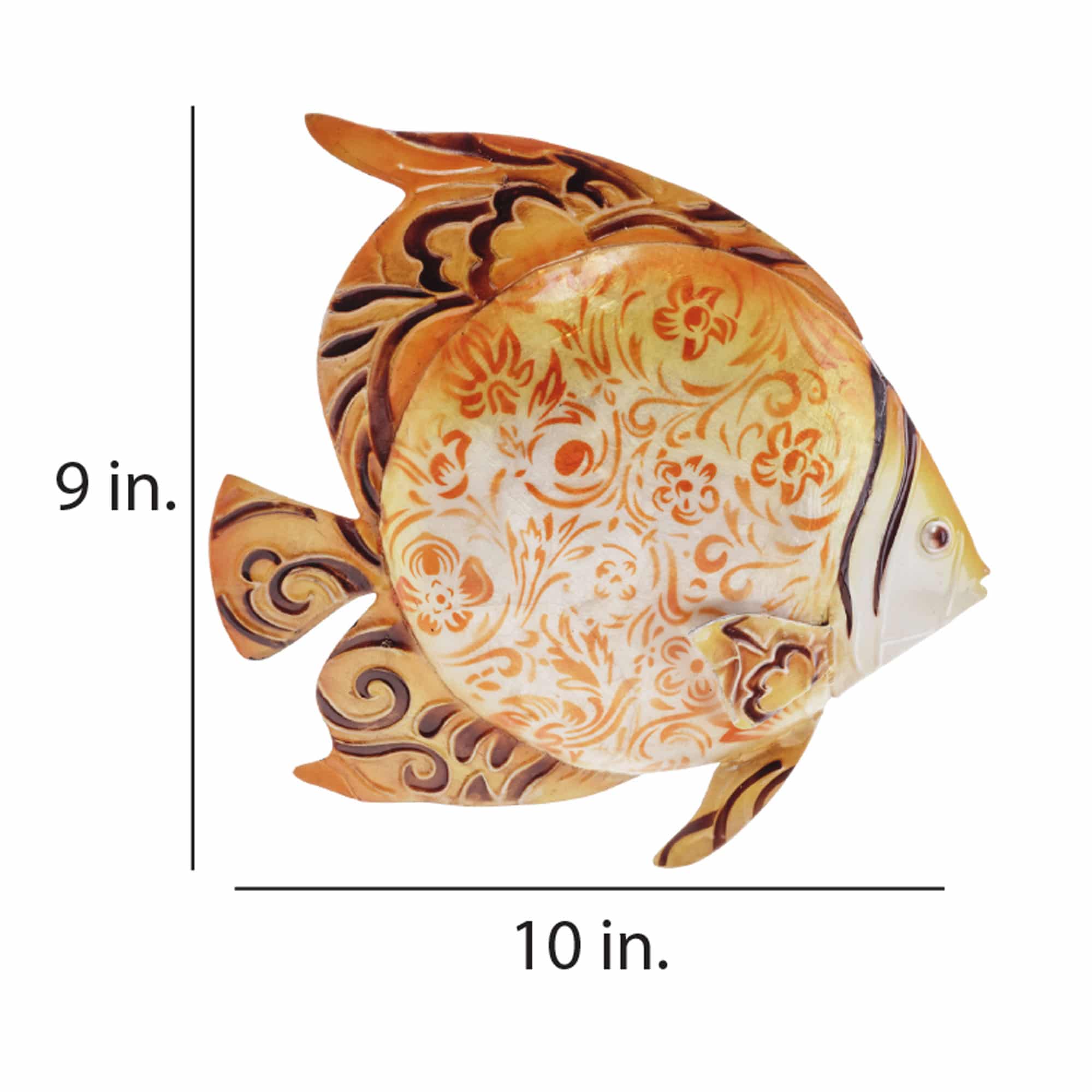
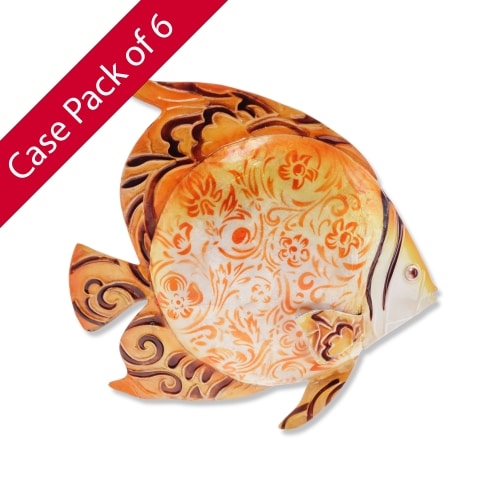 Case of 6 It's big. It's round and it's called an Opah. It looks like a goldfish that seriously outgrew its bowl. The Opah's bright orange is represented in this piece. Instead of spots, the artist took license and painted intricate floral patterns on top of capiz shells. The artist continues by pressing patterns into the tin both in the fins and the face of this magnificent fish. The basic frame of the wall fish is created using tin, which is powder coated as a black finish. The frame is reinforced using wrought iron wire along the inner edge. Capiz is an oyster shell and the primary purpose of the oyster is as a source of food. However, the by-product, the shell, can be used for decoration. Due to it being a natural material, the natural colors of the capiz can come through as tans and browns underneath the paint.
Case of 6 It's big. It's round and it's called an Opah. It looks like a goldfish that seriously outgrew its bowl. The Opah's bright orange is represented in this piece. Instead of spots, the artist took license and painted intricate floral patterns on top of capiz shells. The artist continues by pressing patterns into the tin both in the fins and the face of this magnificent fish. The basic frame of the wall fish is created using tin, which is powder coated as a black finish. The frame is reinforced using wrought iron wire along the inner edge. Capiz is an oyster shell and the primary purpose of the oyster is as a source of food. However, the by-product, the shell, can be used for decoration. Due to it being a natural material, the natural colors of the capiz can come through as tans and browns underneath the paint. -
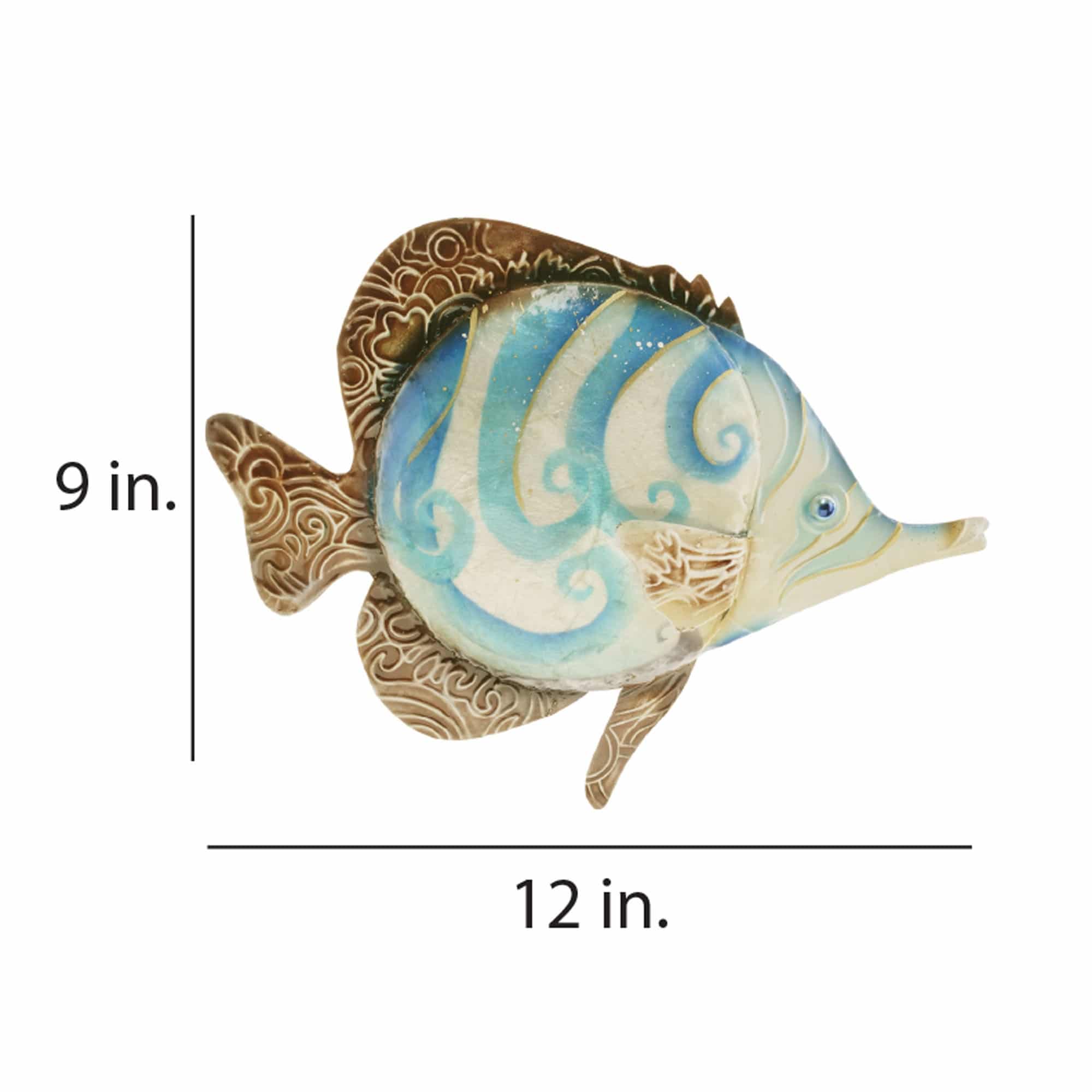
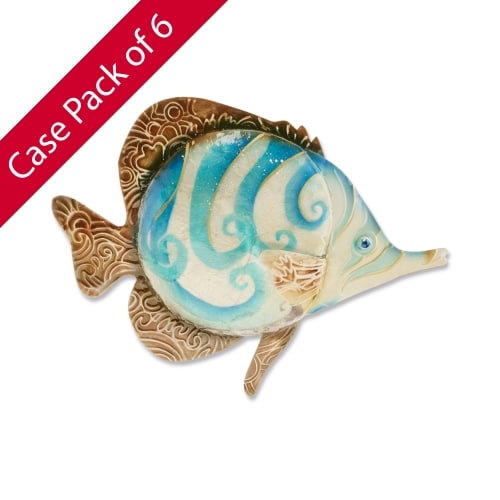 Case of 6 This fish was inspired by the Copperband Butterfly Fish. Though the name is a mouthful, the artist did capture the strips, colors, broad fins, and the beak that this fish is known for. The blue and pearl swirls contrast with its deeper bronze fins. Those fins are further enhanced with a swirled design, creating a very complex piece. The results is a piece rich in design and color. The basic frame of the wall fish is created using tin, which is powder coated as a black finish. The frame is reinforced using wrought iron wire along the inner edge. Capiz is an oyster shell and the primary purpose of the oyster is as a source of food. However, the by-product, the shell, can be used for decoration. Due to it being a natural material, the natural colors of the capiz can come through as tans and browns underneath the paint.
Case of 6 This fish was inspired by the Copperband Butterfly Fish. Though the name is a mouthful, the artist did capture the strips, colors, broad fins, and the beak that this fish is known for. The blue and pearl swirls contrast with its deeper bronze fins. Those fins are further enhanced with a swirled design, creating a very complex piece. The results is a piece rich in design and color. The basic frame of the wall fish is created using tin, which is powder coated as a black finish. The frame is reinforced using wrought iron wire along the inner edge. Capiz is an oyster shell and the primary purpose of the oyster is as a source of food. However, the by-product, the shell, can be used for decoration. Due to it being a natural material, the natural colors of the capiz can come through as tans and browns underneath the paint. -
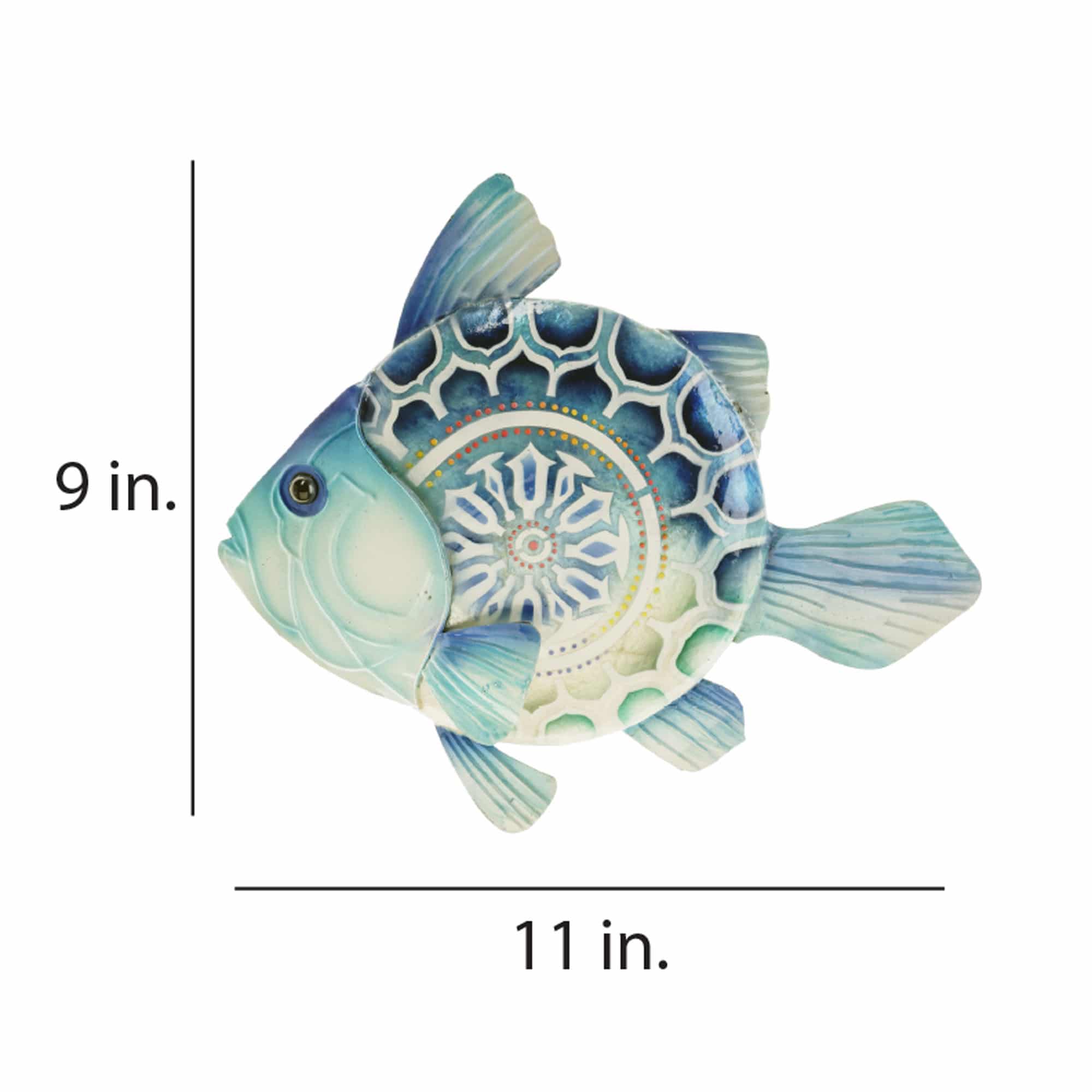
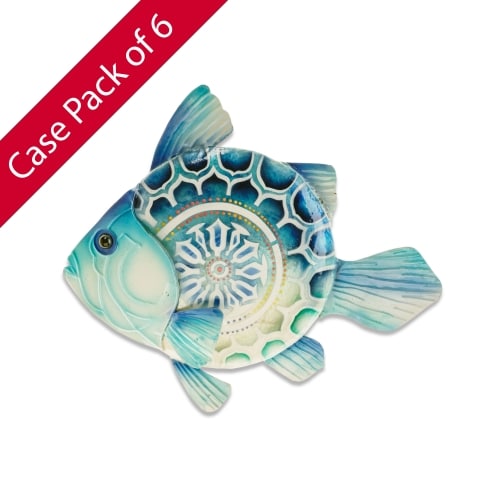 Case of 6 This fish is an artist's interpretation of the blue sea bass. The rich blue tones are common not only on the fish, but also the water within which it resides. The spiky fines and the scaly skin are also captured by the artist. The center of the fish is most interesting as it is adorned with capiz shell, which is hand-painted in wavy lines, representing the movement of the ocean as well as the fish. This piece will bring in color and design to your space and a smile to your face. The basic frame of the wall fish is created using tin, which is powder coated as a black finish. The frame is reinforced using wrought iron wire along the inner edge. Capiz is an oyster shell and the primary purpose of the oyster is as a source of food. However, the by-product, the shell, can be used for decoration. Due to it being a natural material, the natural colors of the capiz can come through as tans and browns underneath the paint.
Case of 6 This fish is an artist's interpretation of the blue sea bass. The rich blue tones are common not only on the fish, but also the water within which it resides. The spiky fines and the scaly skin are also captured by the artist. The center of the fish is most interesting as it is adorned with capiz shell, which is hand-painted in wavy lines, representing the movement of the ocean as well as the fish. This piece will bring in color and design to your space and a smile to your face. The basic frame of the wall fish is created using tin, which is powder coated as a black finish. The frame is reinforced using wrought iron wire along the inner edge. Capiz is an oyster shell and the primary purpose of the oyster is as a source of food. However, the by-product, the shell, can be used for decoration. Due to it being a natural material, the natural colors of the capiz can come through as tans and browns underneath the paint. -
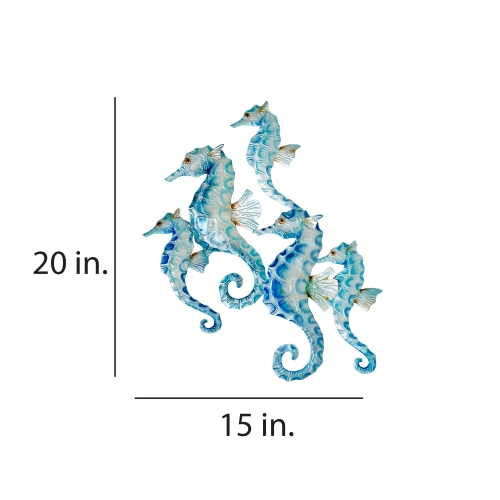
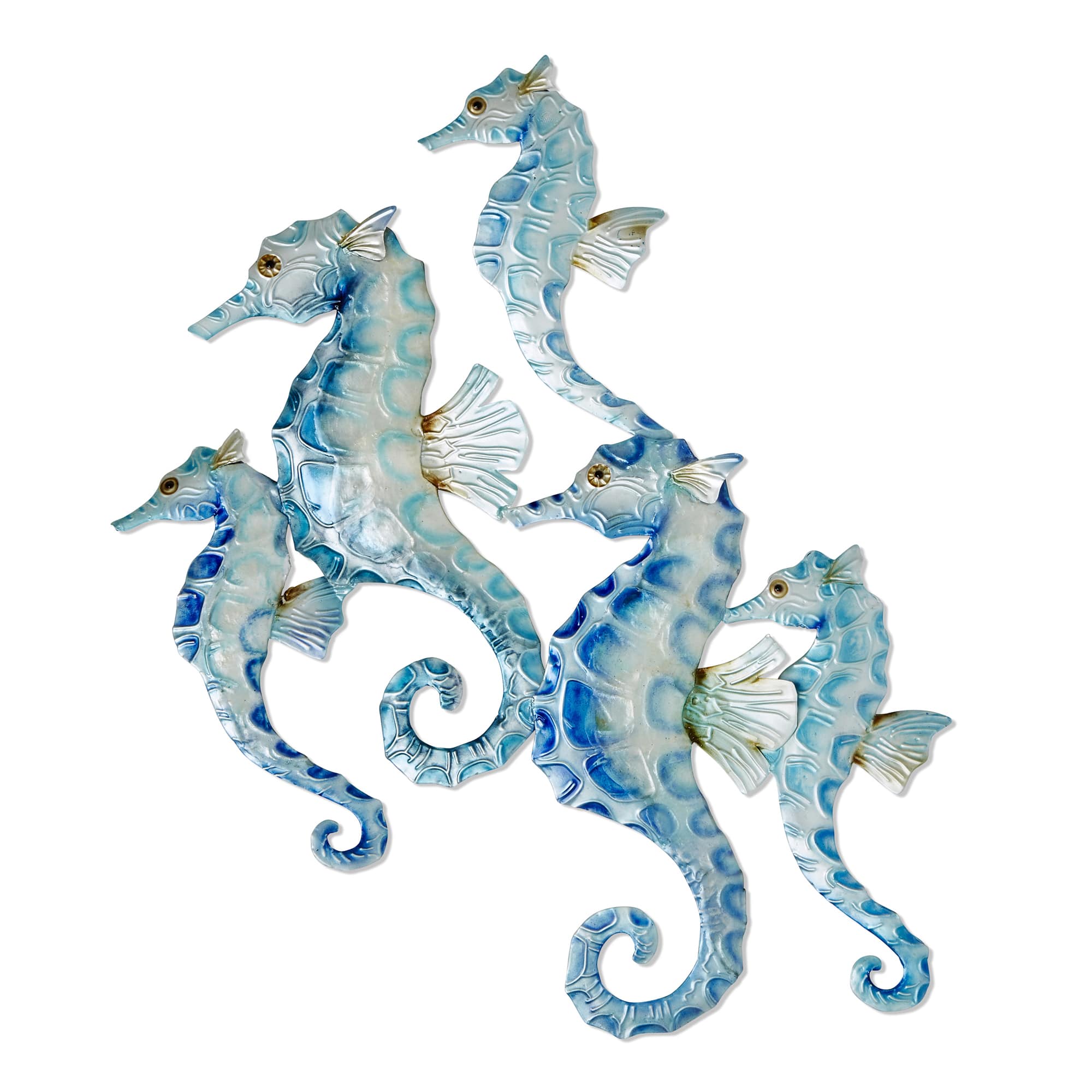 The seahorse has captured the minds and imaginations of people across all cultures for thousands of years. Seen as a symbol of good luck, strength and safety, this unique and beautiful animal is as charming as it is mysterious. The artist captures the beauty of the seahorse with a raised fine, high shine, hand-painted finish, and elegant mother of pearl on their chest and forefront. The basic frame of the wall seahorses is created using tin, which is powder coated as a black finish. Capiz is an oyster shell and the primary purpose of the oyster is as a source of food. However, the by-product, the shell, can be used for decoration. Due to it being a natural material, the natural colors of the capiz can come through as tans and browns.
The seahorse has captured the minds and imaginations of people across all cultures for thousands of years. Seen as a symbol of good luck, strength and safety, this unique and beautiful animal is as charming as it is mysterious. The artist captures the beauty of the seahorse with a raised fine, high shine, hand-painted finish, and elegant mother of pearl on their chest and forefront. The basic frame of the wall seahorses is created using tin, which is powder coated as a black finish. Capiz is an oyster shell and the primary purpose of the oyster is as a source of food. However, the by-product, the shell, can be used for decoration. Due to it being a natural material, the natural colors of the capiz can come through as tans and browns. -

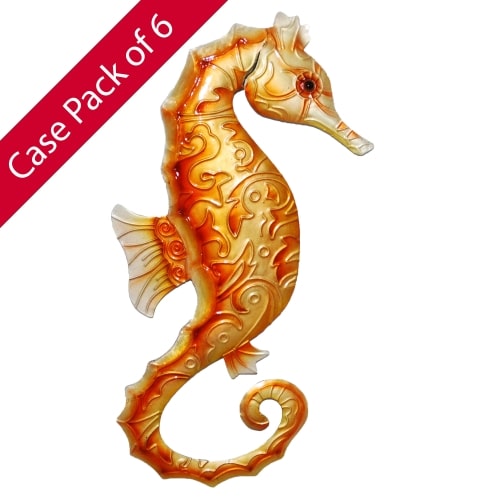 Case of 6 The seahorse has captured the minds and imaginations of people across all cultures for thousands of years. Seen as a symbol of good luck, strength and safety, this unique and beautiful animal is as charming as it is mysterious. The artist captures the beauty of the seahorse with a raised fine, high shine, hand-painted finish, and elegant mother of pearl chest and forefront. The basic frame of the wall seahorse is created using tin, which is powder coated as a black finish. Capiz is an oyster shell and the primary purpose of the oyster is as a source of food. However, the by-product, the shell, can be used for decoration. Due to it being a natural material, the natural colors of the capiz can come through as tans and browns.
Case of 6 The seahorse has captured the minds and imaginations of people across all cultures for thousands of years. Seen as a symbol of good luck, strength and safety, this unique and beautiful animal is as charming as it is mysterious. The artist captures the beauty of the seahorse with a raised fine, high shine, hand-painted finish, and elegant mother of pearl chest and forefront. The basic frame of the wall seahorse is created using tin, which is powder coated as a black finish. Capiz is an oyster shell and the primary purpose of the oyster is as a source of food. However, the by-product, the shell, can be used for decoration. Due to it being a natural material, the natural colors of the capiz can come through as tans and browns. -
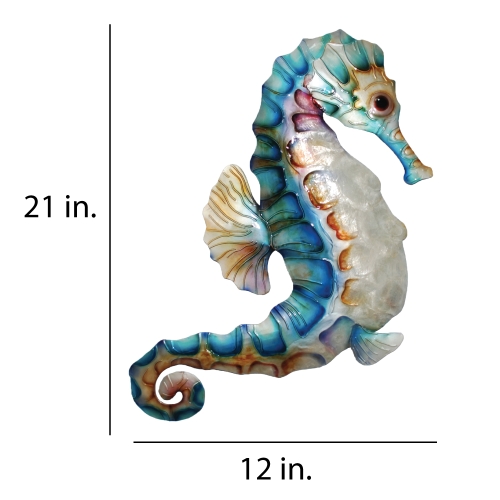
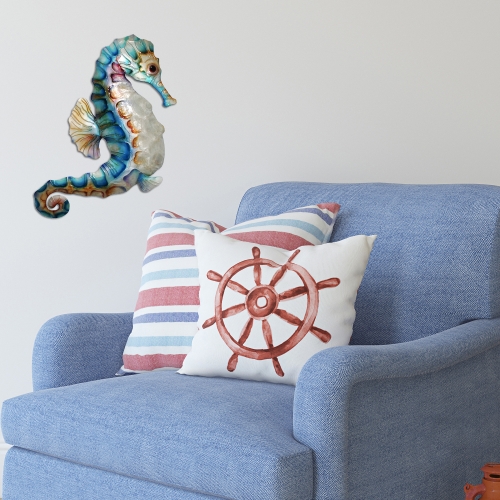 The Seahorse Wall Décor is a beautiful and unique addition to any home. The seahorse symbolizes discovery of balance in life and transformation of energy into positive thoughts. And because of the way seahorses move, they're also symbolic of peace and patience. The artist captures the splendor of the seahorse with a raised fin, high shine hand-painted finish, and capiz oyster shell chest and forefront. The Seahorse Wall Décor is the perfect way to bring good luck, strength, and beauty into your home. The basic frame of the Seahorse is created using tin, which is powder-coated with a black finish and makes this piece safe to use outdoors. The edges of the frame are reinforced using thicker tin wire. The front of this piece is adorned in areas with capiz shell, an oyster native to the Philippines, before being hand-painted and sealed with a water-based sealant. The primary purpose of this oyster to provide a source of food, however, the shell is a sustainable by-product that can be used for decoration. The capiz shell subtly replicates the reflective qualities of seahorses in nature. The entire piece is lightweight and has an eyelet in the back allowing it to be hung using a finishing nail, command strip, or a push pin. Due to it being a natural material, the organic colors of capiz come through as tans and browns underneath the paint.
The Seahorse Wall Décor is a beautiful and unique addition to any home. The seahorse symbolizes discovery of balance in life and transformation of energy into positive thoughts. And because of the way seahorses move, they're also symbolic of peace and patience. The artist captures the splendor of the seahorse with a raised fin, high shine hand-painted finish, and capiz oyster shell chest and forefront. The Seahorse Wall Décor is the perfect way to bring good luck, strength, and beauty into your home. The basic frame of the Seahorse is created using tin, which is powder-coated with a black finish and makes this piece safe to use outdoors. The edges of the frame are reinforced using thicker tin wire. The front of this piece is adorned in areas with capiz shell, an oyster native to the Philippines, before being hand-painted and sealed with a water-based sealant. The primary purpose of this oyster to provide a source of food, however, the shell is a sustainable by-product that can be used for decoration. The capiz shell subtly replicates the reflective qualities of seahorses in nature. The entire piece is lightweight and has an eyelet in the back allowing it to be hung using a finishing nail, command strip, or a push pin. Due to it being a natural material, the organic colors of capiz come through as tans and browns underneath the paint. -
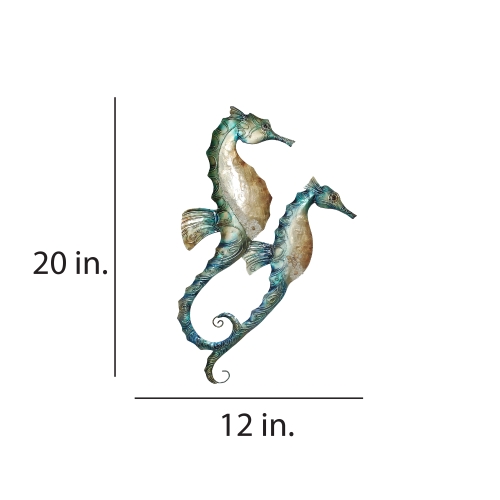
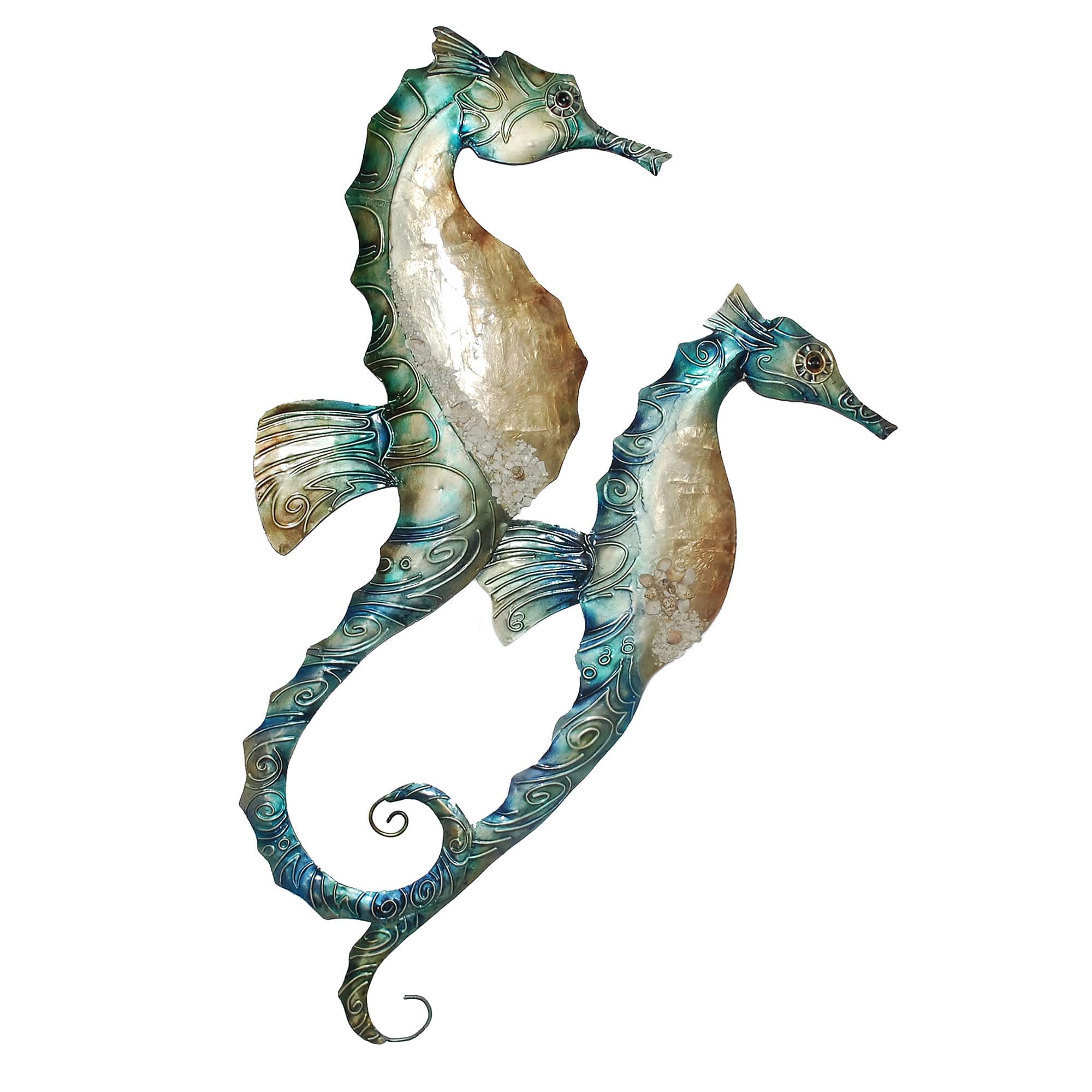 The seahorse has captured the minds and imaginations of people across all cultures for thousands of years. Seen as a symbol of good luck, strength and safety, this unique and beautiful animal is as charming as it is mysterious. The artist captures the beauty of the seahorse with a raised fine, high shine, hand-painted finish, and elegant mother of pearl on their chest and forefront. The basic frame of the wall seahorses is created using tin, which is powder coated as a black finish. Capiz is an oyster shell and the primary purpose of the oyster is as a source of food. However, the by-product, the shell, can be used for decoration. Due to it being a natural material, the natural colors of the capiz can come through as tans and browns.
The seahorse has captured the minds and imaginations of people across all cultures for thousands of years. Seen as a symbol of good luck, strength and safety, this unique and beautiful animal is as charming as it is mysterious. The artist captures the beauty of the seahorse with a raised fine, high shine, hand-painted finish, and elegant mother of pearl on their chest and forefront. The basic frame of the wall seahorses is created using tin, which is powder coated as a black finish. Capiz is an oyster shell and the primary purpose of the oyster is as a source of food. However, the by-product, the shell, can be used for decoration. Due to it being a natural material, the natural colors of the capiz can come through as tans and browns. -
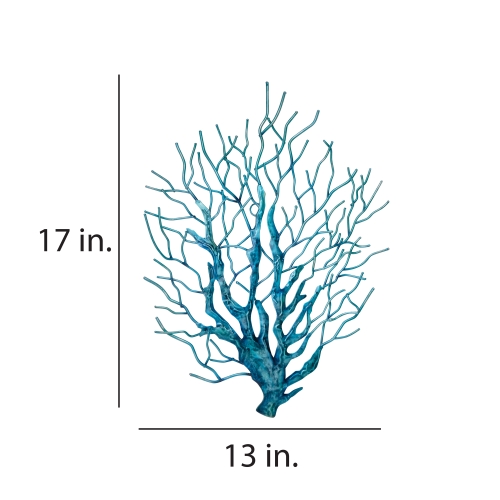
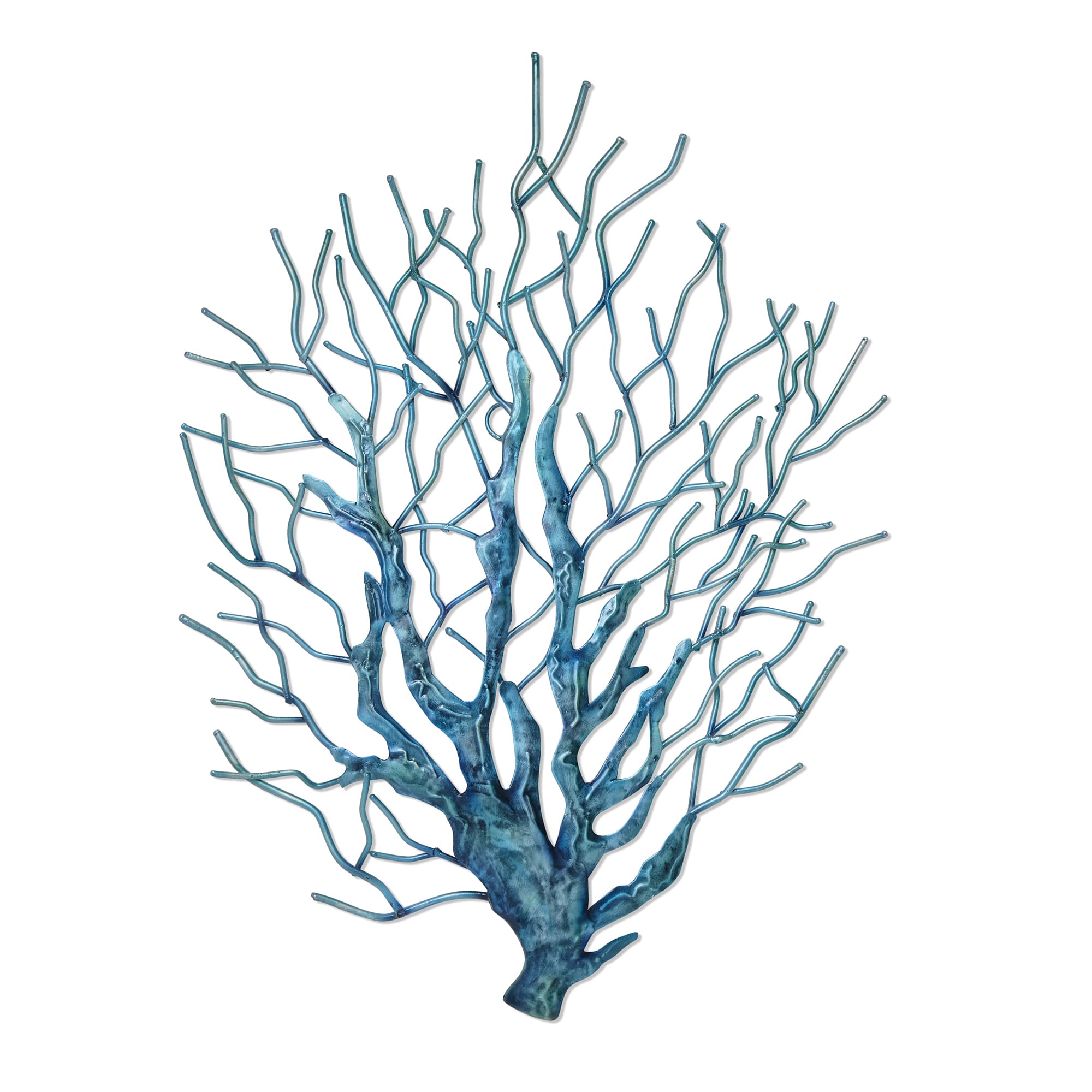 This piece features ten schooling mackerels swimming calmly with fins raised as if catching an ocean current. In their largest numbers, mackerels have been found to travel in schools that stretch as far as 20 miles. Painted by hand the artist uses aqua tones reminiscent of its ocean habitat. Capiz oyster shell adorn the front adding a watery shimmer. The basic frame of this piece is created using tin, which is powder coated with a black finish. The frame is reinforced using tin wire along the inner edge. The front of the body is adorned with capiz. Capiz is an oyster shell and the primary purpose of the oyster is as a source of food. However, the by-product, the shell, can be used for decoration. Due to it being a natural material, the natural colors of the capiz may come through as tans and browns underneath the hand-painted surface.
This piece features ten schooling mackerels swimming calmly with fins raised as if catching an ocean current. In their largest numbers, mackerels have been found to travel in schools that stretch as far as 20 miles. Painted by hand the artist uses aqua tones reminiscent of its ocean habitat. Capiz oyster shell adorn the front adding a watery shimmer. The basic frame of this piece is created using tin, which is powder coated with a black finish. The frame is reinforced using tin wire along the inner edge. The front of the body is adorned with capiz. Capiz is an oyster shell and the primary purpose of the oyster is as a source of food. However, the by-product, the shell, can be used for decoration. Due to it being a natural material, the natural colors of the capiz may come through as tans and browns underneath the hand-painted surface. -
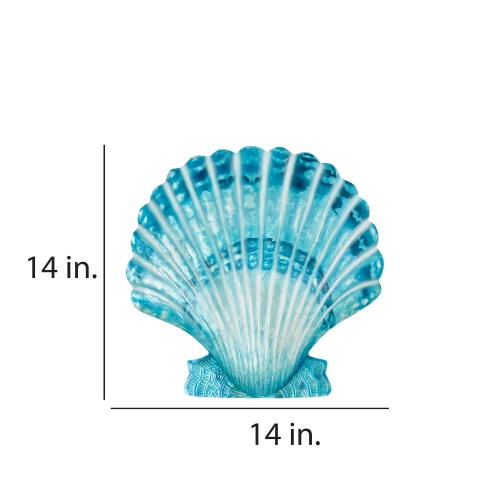
 The design is based on the shape of the Senatorial scallop found in the tropical waters of the pacific. Like the rings of a tree, one can determine the age of a scallop my counting the rings on its shell. Each ring represents one year of growth. The artist using this feature to add beautiful detail along with a deep aqua color to reflect its ocean habitat. Real capiz oyster shell adorns the exterior giving this piece a shimmer as if light were bouncing off its shell from under water. The basic frame of this piece is created using tin, which is powder coated with a black finish. The frame is reinforced using tin wire along the inner edge. The front of the body is adorned with capiz. Capiz is an oyster shell and the primary purpose of the oyster is as a source of food. However, the by-product, the shell, can be used for decoration. Due to it being a natural material, the natural colors of the capiz may come through as tans and browns underneath the hand-painted surface.
The design is based on the shape of the Senatorial scallop found in the tropical waters of the pacific. Like the rings of a tree, one can determine the age of a scallop my counting the rings on its shell. Each ring represents one year of growth. The artist using this feature to add beautiful detail along with a deep aqua color to reflect its ocean habitat. Real capiz oyster shell adorns the exterior giving this piece a shimmer as if light were bouncing off its shell from under water. The basic frame of this piece is created using tin, which is powder coated with a black finish. The frame is reinforced using tin wire along the inner edge. The front of the body is adorned with capiz. Capiz is an oyster shell and the primary purpose of the oyster is as a source of food. However, the by-product, the shell, can be used for decoration. Due to it being a natural material, the natural colors of the capiz may come through as tans and browns underneath the hand-painted surface. -
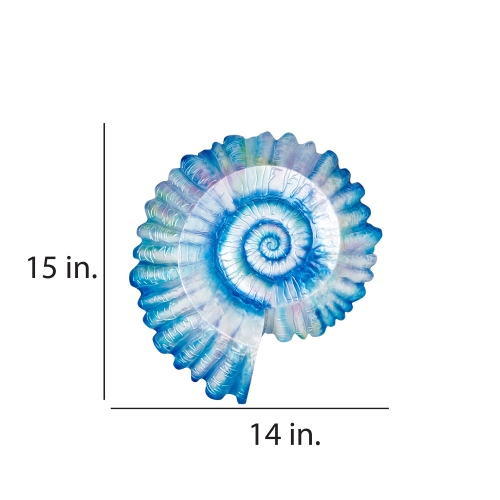
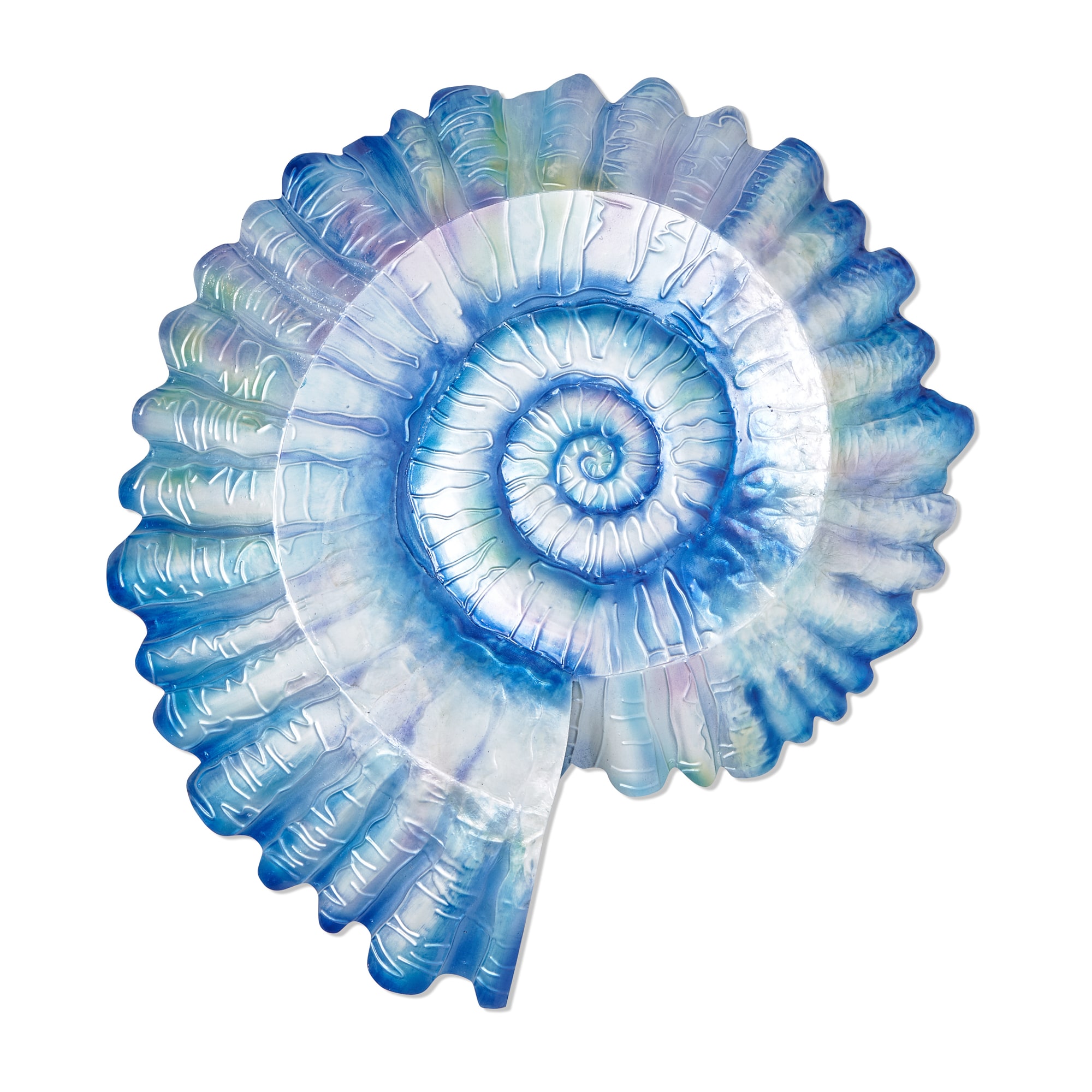 The spiral, flat seashell shape is a familiar one, but few know what actually live inside. This shell belongs to a creature known as a nautilus. Related to octopus, this creature is mobile, able to jettison itself through the ocean with streams of water. The artist captures its classic shape and adds deep shades of sea blue. Capiz oyster shell adorns its exterior as if it were glistening under water. The basic frame of this piece is created using tin, which is powder coated with a black finish. The frame is reinforced using tin wire along the inner edge. The front of the body is adorned with capiz. Capiz is an oyster shell and the primary purpose of the oyster is as a source of food. However, the by-product, the shell, can be used for decoration. Due to it being a natural material, the natural colors of the capiz may come through as tans and browns underneath the hand-painted surface.
The spiral, flat seashell shape is a familiar one, but few know what actually live inside. This shell belongs to a creature known as a nautilus. Related to octopus, this creature is mobile, able to jettison itself through the ocean with streams of water. The artist captures its classic shape and adds deep shades of sea blue. Capiz oyster shell adorns its exterior as if it were glistening under water. The basic frame of this piece is created using tin, which is powder coated with a black finish. The frame is reinforced using tin wire along the inner edge. The front of the body is adorned with capiz. Capiz is an oyster shell and the primary purpose of the oyster is as a source of food. However, the by-product, the shell, can be used for decoration. Due to it being a natural material, the natural colors of the capiz may come through as tans and browns underneath the hand-painted surface. -
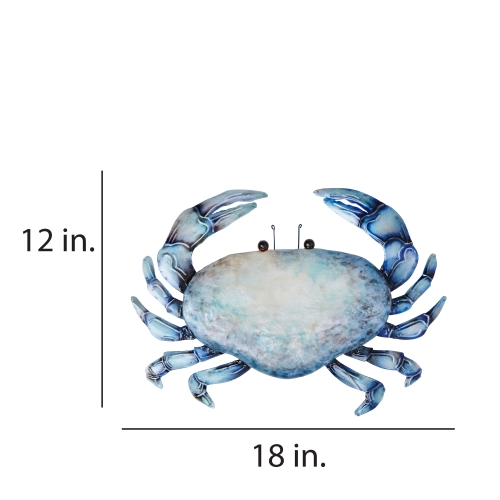
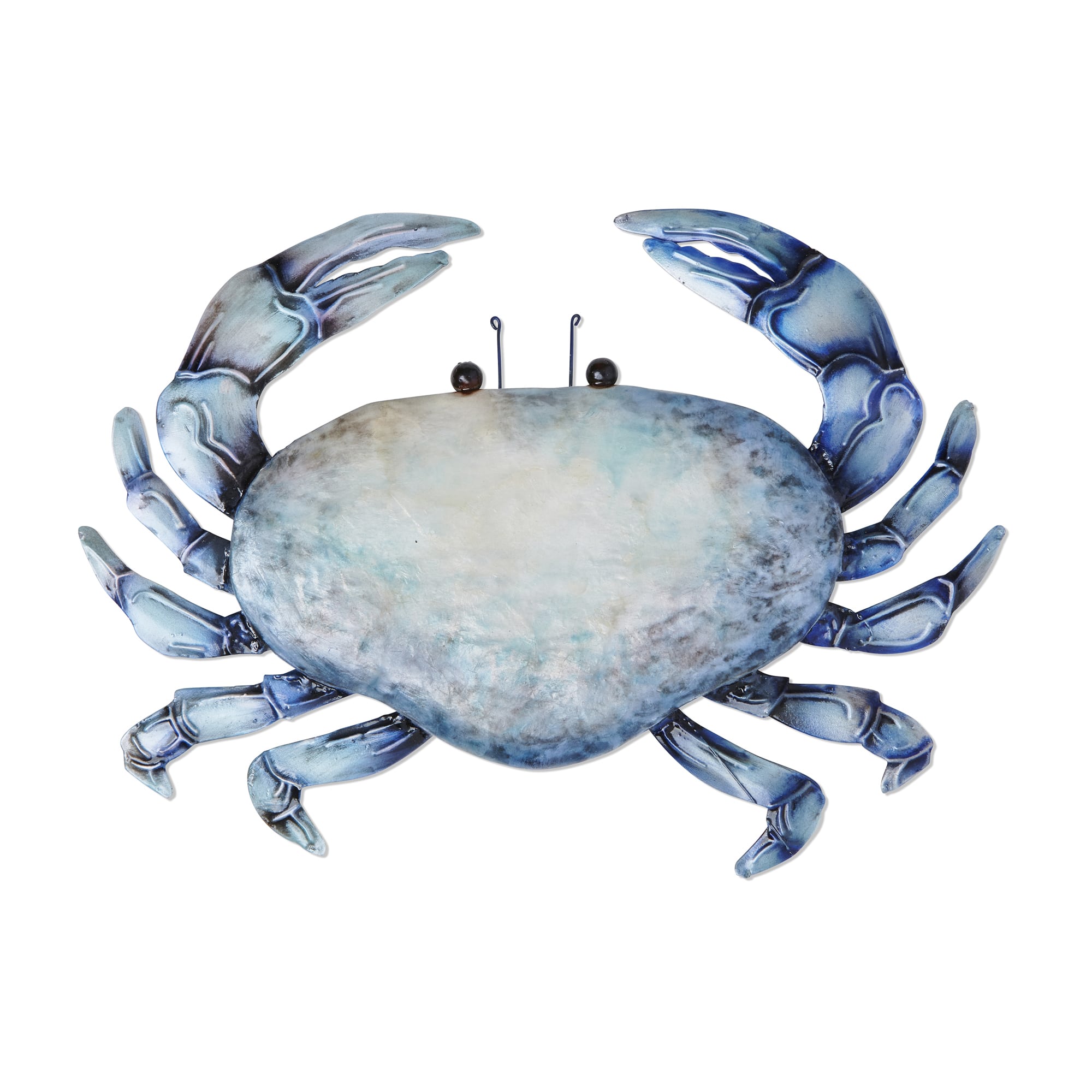 The frame of the piece is an Emerald Crab, which are commonly found in tropical waters of the Caribbean Sea. The maritime blue colors reflect the waters of its natural habitat while exhibiting calm and cool colors. The artist also creates slight contrasts between the body of the crab using capiz oyster shells and the matted outer legs and pinchers. The body will reflect light making it seem bolder. The basic frame of this piece is created using tin, which is powder coated with a black finish. The frame is reinforced using tin wire along the inner edge. The front of the body is adorned with capiz. Capiz is an oyster shell and the primary purpose of the oyster is as a source of food. However, the by-product, the shell, can be used for decoration. Due to it being a natural material, the natural colors of the capiz may come through as tans and browns underneath the hand-painted surface.
The frame of the piece is an Emerald Crab, which are commonly found in tropical waters of the Caribbean Sea. The maritime blue colors reflect the waters of its natural habitat while exhibiting calm and cool colors. The artist also creates slight contrasts between the body of the crab using capiz oyster shells and the matted outer legs and pinchers. The body will reflect light making it seem bolder. The basic frame of this piece is created using tin, which is powder coated with a black finish. The frame is reinforced using tin wire along the inner edge. The front of the body is adorned with capiz. Capiz is an oyster shell and the primary purpose of the oyster is as a source of food. However, the by-product, the shell, can be used for decoration. Due to it being a natural material, the natural colors of the capiz may come through as tans and browns underneath the hand-painted surface. -
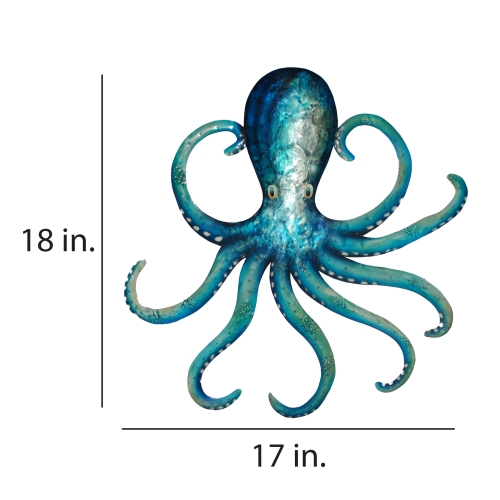
 The octopus has become known for its intelligence and curious nature. No other animal outside of birds and mammals has as large of a brain compared to the size its body as does the octopus. With eyes wide open, the artist reflects the inquisitive nature of this sea creature. Tones of blue represent its aquatic habitat. The use of capiz oyster shell bounces light from the front of this piece as if its reflecting light under water. The basic frame of this piece is created using tin, which is powder coated with a black finish. The frame is reinforced using tin wire along the inner edge. The front of the body is adorned with capiz. Capiz is an oyster shell and the primary purpose of the oyster is as a source of food. However, the by-product, the shell, can be used for decoration. Due to it being a natural material, the natural colors of the capiz may come through as tans and browns underneath the hand-painted surface.
The octopus has become known for its intelligence and curious nature. No other animal outside of birds and mammals has as large of a brain compared to the size its body as does the octopus. With eyes wide open, the artist reflects the inquisitive nature of this sea creature. Tones of blue represent its aquatic habitat. The use of capiz oyster shell bounces light from the front of this piece as if its reflecting light under water. The basic frame of this piece is created using tin, which is powder coated with a black finish. The frame is reinforced using tin wire along the inner edge. The front of the body is adorned with capiz. Capiz is an oyster shell and the primary purpose of the oyster is as a source of food. However, the by-product, the shell, can be used for decoration. Due to it being a natural material, the natural colors of the capiz may come through as tans and browns underneath the hand-painted surface. -
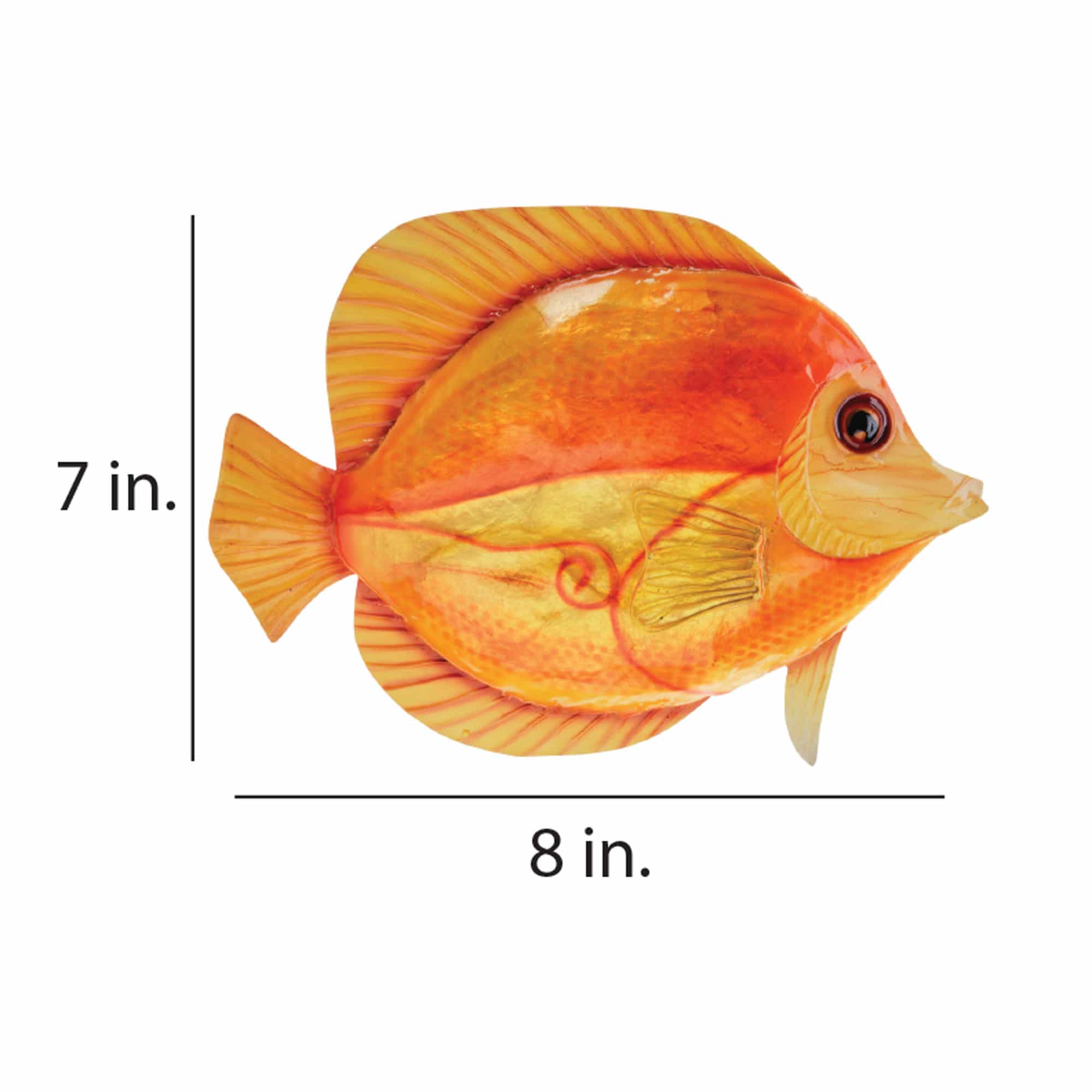
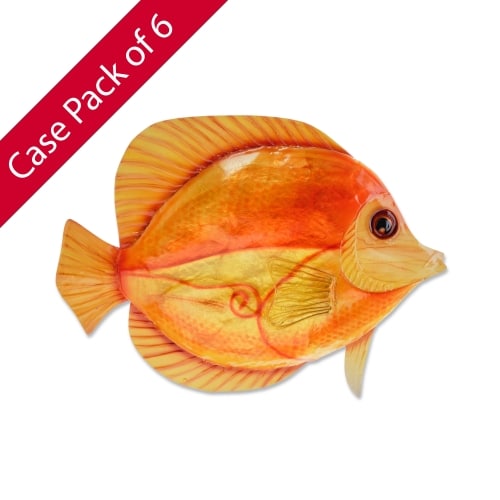 Case of 6 The discus fish is native to the Amazon river basin. These fish are known for their distinctive shape, bright colors, and unique patterns. The artist who painted this fish paid attention to the interacting color patterns. Using capiz shell, he emulated the natural scales of this fish. The basic frame of the wall fish is created using tin, which is powder coated as a black finish. The frame is reinforced using wrought iron wire along the inner edge. Capiz is an oyster shell and the primary purpose of the oyster is as a source of food. However, the by-product, the shell, can be used for decoration. Due to it being a natural material, the natural colors of the capiz can come through as tans and browns underneath the paint.
Case of 6 The discus fish is native to the Amazon river basin. These fish are known for their distinctive shape, bright colors, and unique patterns. The artist who painted this fish paid attention to the interacting color patterns. Using capiz shell, he emulated the natural scales of this fish. The basic frame of the wall fish is created using tin, which is powder coated as a black finish. The frame is reinforced using wrought iron wire along the inner edge. Capiz is an oyster shell and the primary purpose of the oyster is as a source of food. However, the by-product, the shell, can be used for decoration. Due to it being a natural material, the natural colors of the capiz can come through as tans and browns underneath the paint. -
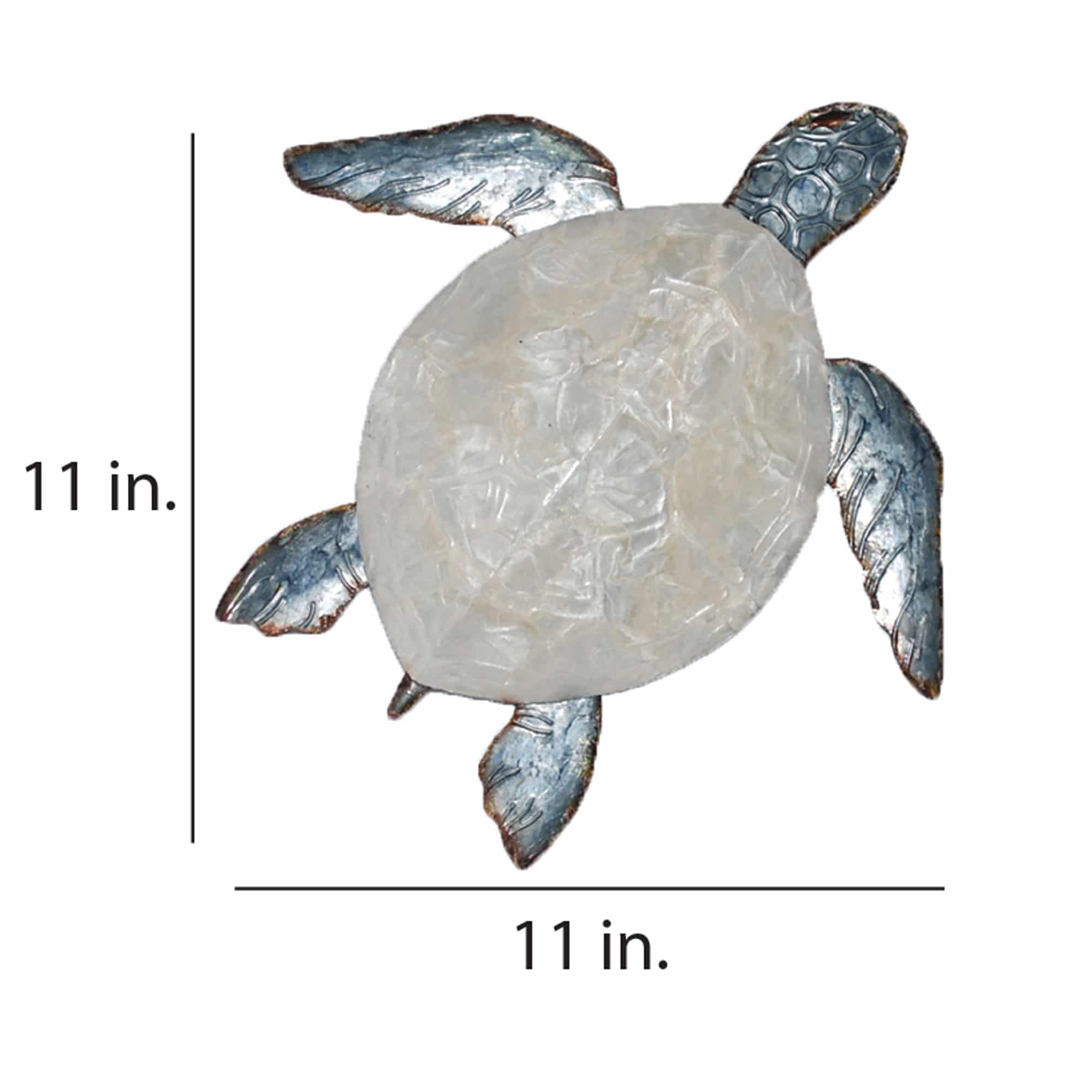
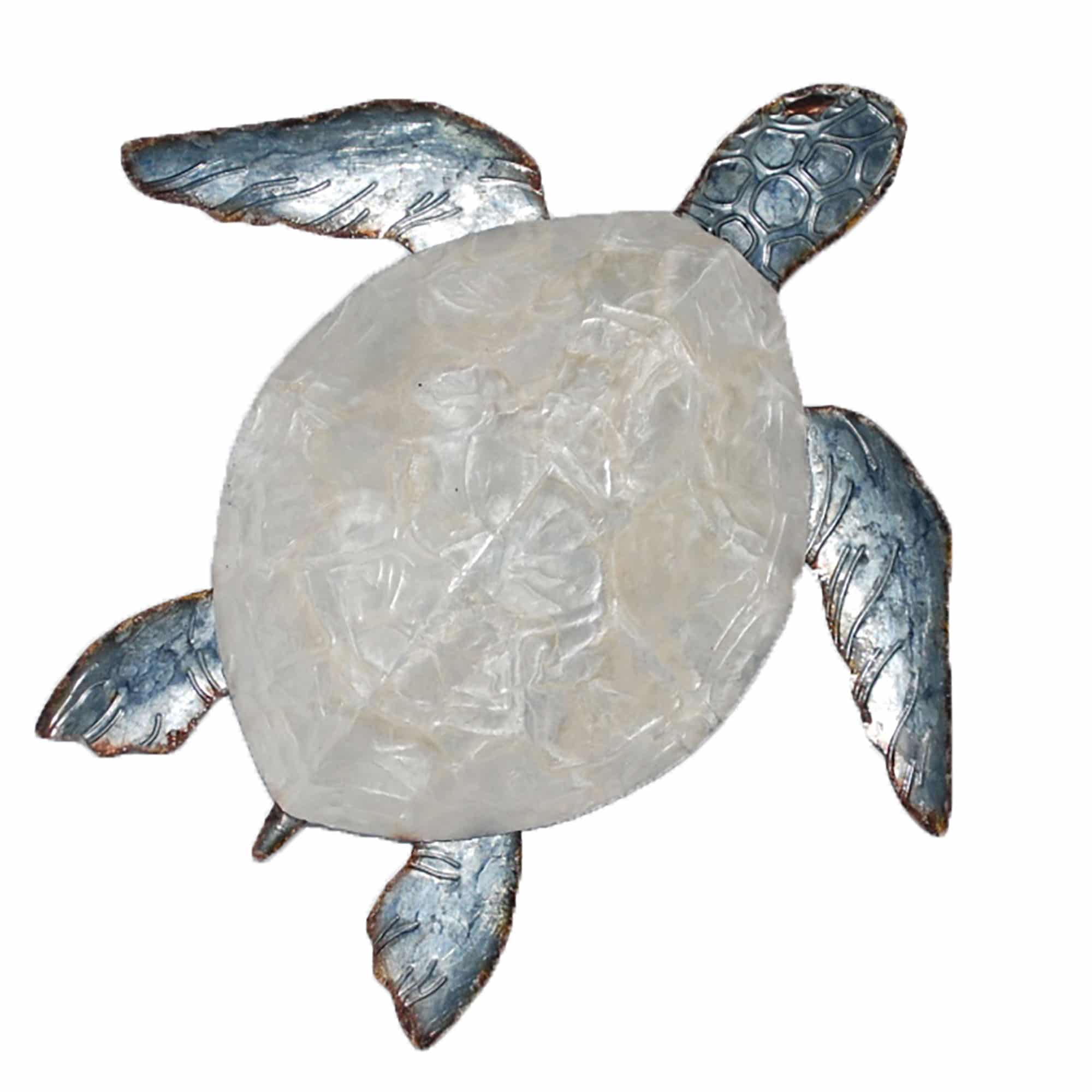 Sea turtles are among the most ancient species on this planet. Today there are seven species of sea turtle remaining that date back 110 million years, back to the age of the dinosaurs. This piece features the Loggerhead turtle, one of the most recognizable of all the sea. This creature is known for its scaled skin, which the artist carefully etches into the metal of the turtle's head and throughout the tips and edges of its body. The shell of the turtle glistens which the artist recreates using capiz shell. The focus of this awe-inspiring piece is the texture and size of sea turtles and the artist uses contrasting colors to underscore this fact. The basic frame of the turtle is created using tin, which is powder coated with a black finish. The frame is reinforced using tin wire along the inner edge. Capiz is an oyster shell and the primary purpose of the oyster is as a source of food. However, the by-product, the shell, can be used for decoration. Due to it being a natural material, the natural colors of the capiz come through as tans and browns underneath the paint. The shell is then painted the bold colors you see. The entire front facing piece is carefully hand-painted keeping in mind the reflective qualities in the color of turtles.
Sea turtles are among the most ancient species on this planet. Today there are seven species of sea turtle remaining that date back 110 million years, back to the age of the dinosaurs. This piece features the Loggerhead turtle, one of the most recognizable of all the sea. This creature is known for its scaled skin, which the artist carefully etches into the metal of the turtle's head and throughout the tips and edges of its body. The shell of the turtle glistens which the artist recreates using capiz shell. The focus of this awe-inspiring piece is the texture and size of sea turtles and the artist uses contrasting colors to underscore this fact. The basic frame of the turtle is created using tin, which is powder coated with a black finish. The frame is reinforced using tin wire along the inner edge. Capiz is an oyster shell and the primary purpose of the oyster is as a source of food. However, the by-product, the shell, can be used for decoration. Due to it being a natural material, the natural colors of the capiz come through as tans and browns underneath the paint. The shell is then painted the bold colors you see. The entire front facing piece is carefully hand-painted keeping in mind the reflective qualities in the color of turtles. -
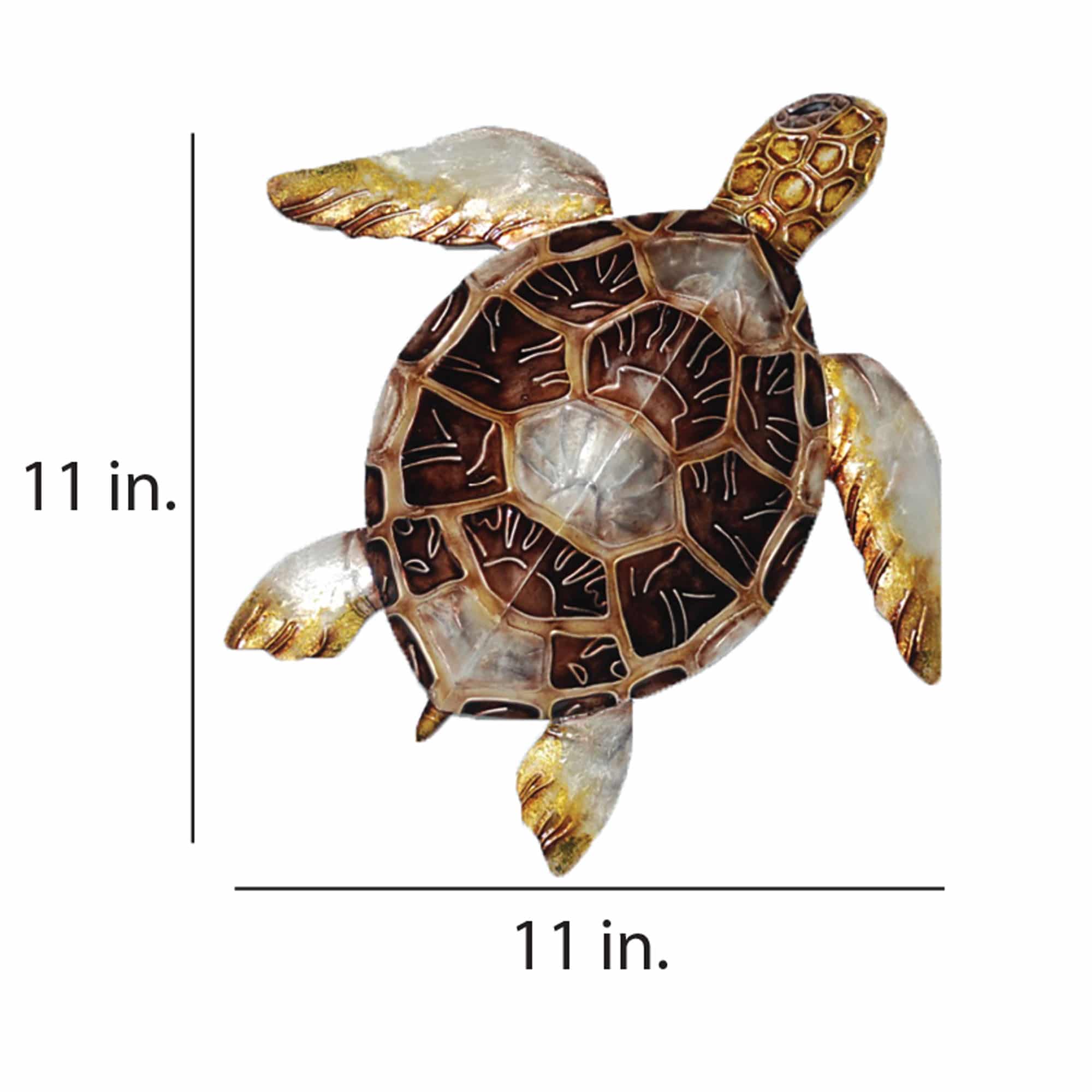
 Sea turtles are among the most ancient species on this planet. Today there are seven species of sea turtle remaining that date back 110 million years, back to the age of the dinosaurs. This piece features the Loggerhead turtle, one of the most recognizable of all the sea. This creature is known for its scaled skin, which the artist carefully etches into the metal of the turtle's head and throughout the tips and edges of its body. The shell of the turtle glistens which the artist recreates using capiz shell. The focus of this awe-inspiring piece is the texture and size of sea turtles and the artist uses contrasting colors to underscore this fact. The basic frame of the turtle is created using tin, which is powder coated with a black finish. The frame is reinforced using tin wire along the inner edge. Capiz is an oyster shell and the primary purpose of the oyster is as a source of food. However, the by-product, the shell, can be used for decoration. Due to it being a natural material, the natural colors of the capiz come through as tans and browns underneath the paint. The shell is then painted the bold colors you see. The entire front facing piece is carefully hand-painted keeping in mind the reflective qualities in the color of turtles.
Sea turtles are among the most ancient species on this planet. Today there are seven species of sea turtle remaining that date back 110 million years, back to the age of the dinosaurs. This piece features the Loggerhead turtle, one of the most recognizable of all the sea. This creature is known for its scaled skin, which the artist carefully etches into the metal of the turtle's head and throughout the tips and edges of its body. The shell of the turtle glistens which the artist recreates using capiz shell. The focus of this awe-inspiring piece is the texture and size of sea turtles and the artist uses contrasting colors to underscore this fact. The basic frame of the turtle is created using tin, which is powder coated with a black finish. The frame is reinforced using tin wire along the inner edge. Capiz is an oyster shell and the primary purpose of the oyster is as a source of food. However, the by-product, the shell, can be used for decoration. Due to it being a natural material, the natural colors of the capiz come through as tans and browns underneath the paint. The shell is then painted the bold colors you see. The entire front facing piece is carefully hand-painted keeping in mind the reflective qualities in the color of turtles. -
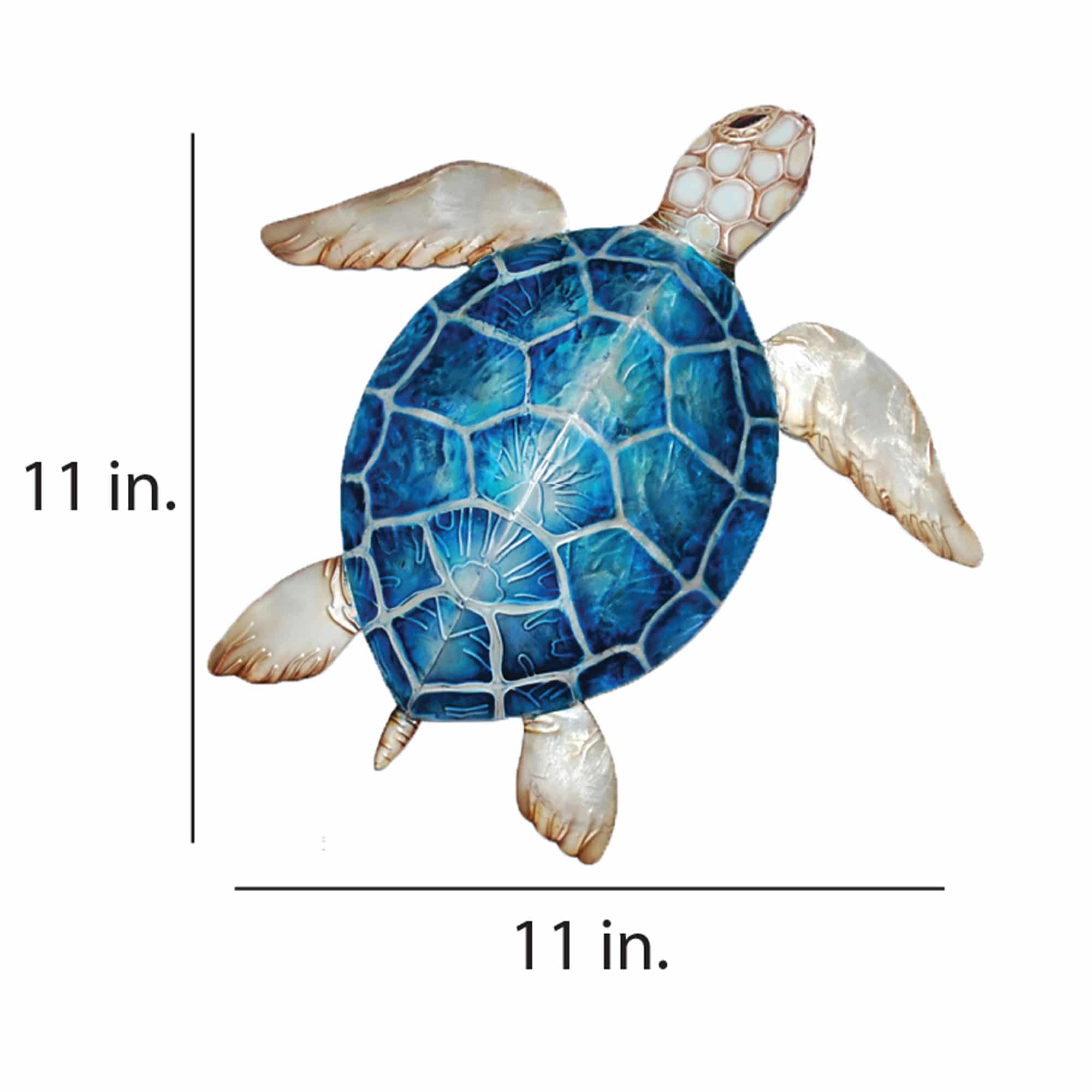
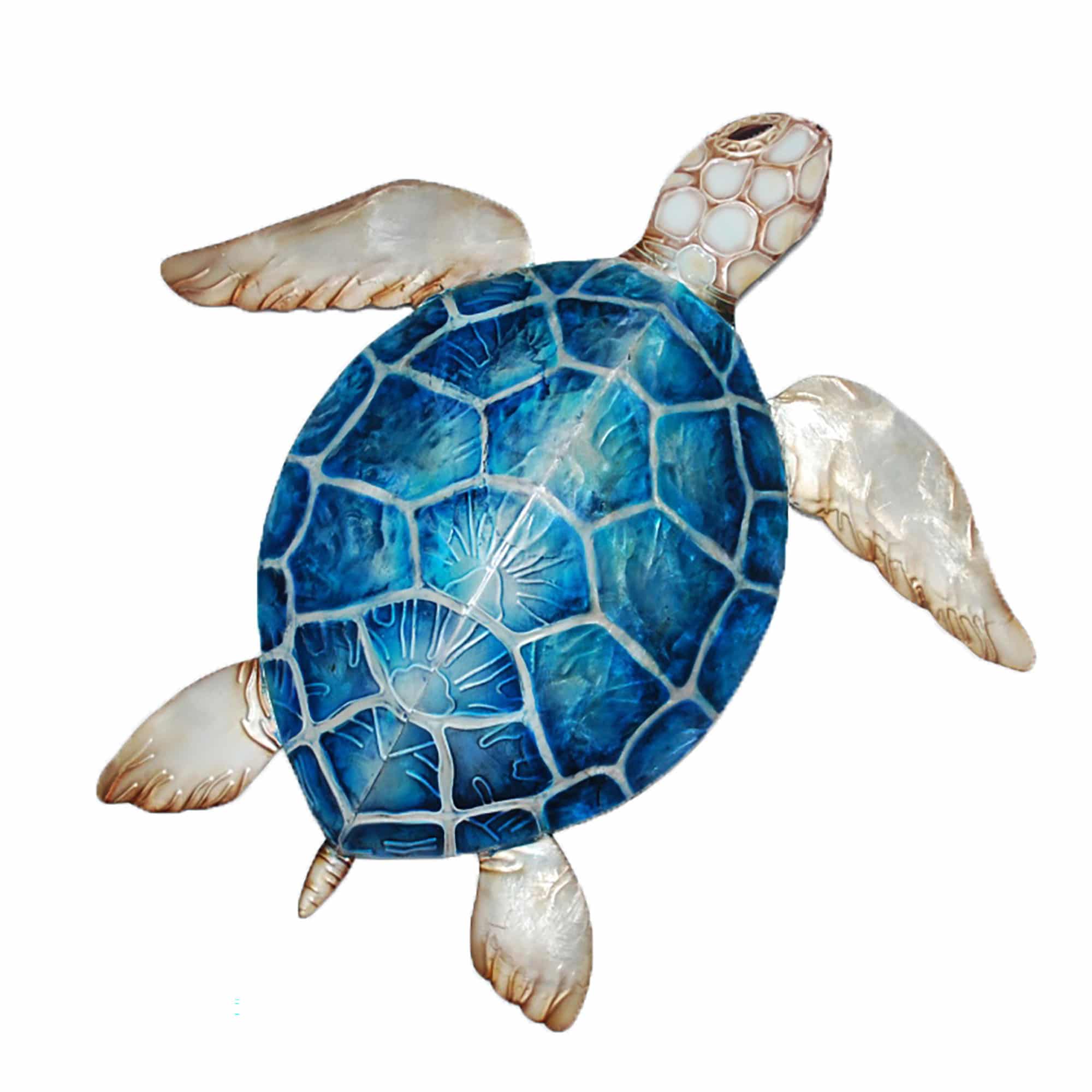 Sea turtles are among the most ancient species on this planet. Today there are seven species of sea turtle remaining that date back 110 million years, back to the age of the dinosaurs. This piece features the Loggerhead turtle, one of the most recognizable of all the sea. This creature is known for its scaled skin, which the artist carefully etches into the metal of the turtle's head and throughout the tips and edges of its body. The shell of the turtle glistens which the artist recreates using capiz shell. The focus of this awe-inspiring piece is the texture and size of sea turtles and the artist uses contrasting colors to underscore this fact. The basic frame of the turtle is created using tin, which is powder coated with a black finish. The frame is reinforced using tin wire along the inner edge. Capiz is an oyster shell and the primary purpose of the oyster is as a source of food. However, the by-product, the shell, can be used for decoration. Due to it being a natural material, the natural colors of the capiz come through as tans and browns underneath the paint. The shell is then painted the bold colors you see. The entire front facing piece is carefully hand-painted keeping in mind the reflective qualities in the color of turtles.
Sea turtles are among the most ancient species on this planet. Today there are seven species of sea turtle remaining that date back 110 million years, back to the age of the dinosaurs. This piece features the Loggerhead turtle, one of the most recognizable of all the sea. This creature is known for its scaled skin, which the artist carefully etches into the metal of the turtle's head and throughout the tips and edges of its body. The shell of the turtle glistens which the artist recreates using capiz shell. The focus of this awe-inspiring piece is the texture and size of sea turtles and the artist uses contrasting colors to underscore this fact. The basic frame of the turtle is created using tin, which is powder coated with a black finish. The frame is reinforced using tin wire along the inner edge. Capiz is an oyster shell and the primary purpose of the oyster is as a source of food. However, the by-product, the shell, can be used for decoration. Due to it being a natural material, the natural colors of the capiz come through as tans and browns underneath the paint. The shell is then painted the bold colors you see. The entire front facing piece is carefully hand-painted keeping in mind the reflective qualities in the color of turtles. -
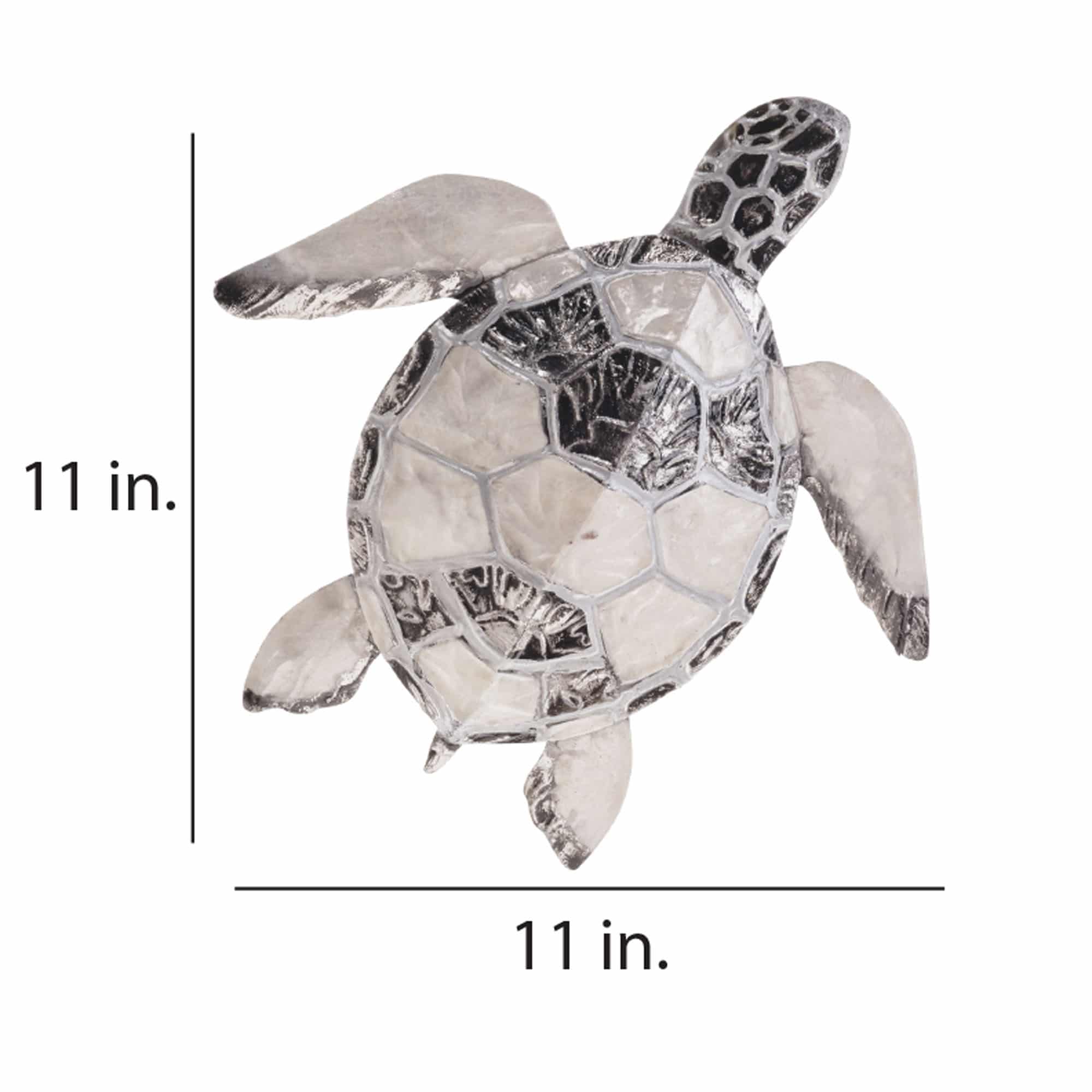
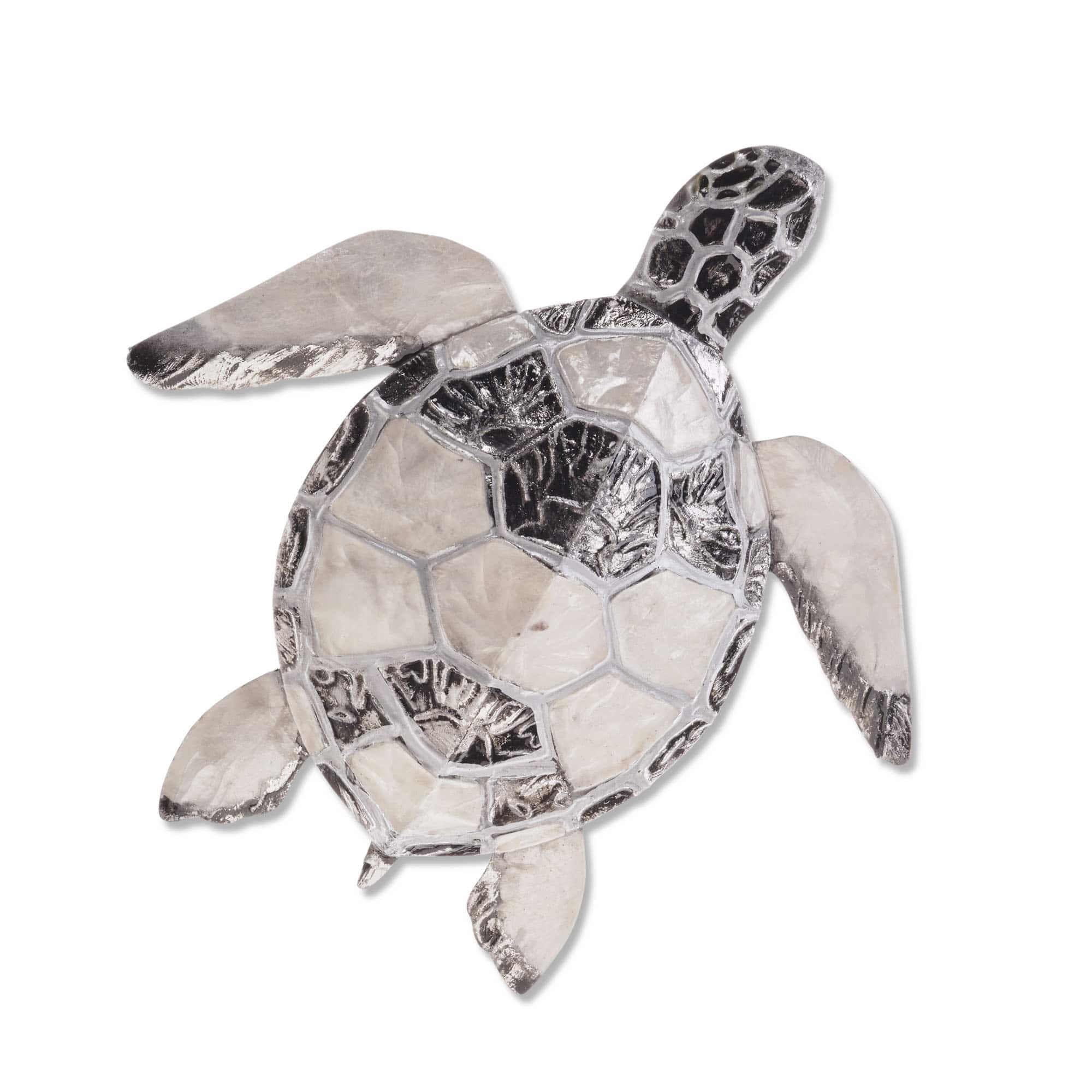 Sea turtles are among the most ancient species on this planet. Today there are seven species of sea turtle remaining that date back 110 million years, back to the age of the dinosaurs. This piece features the Loggerhead turtle, one of the most recognizable of all the sea. This creature is known for its scaled skin, which the artist carefully etches into the metal of the turtle's head and throughout the tips and edges of its body. The shell of the turtle glistens which the artist recreates using capiz shell. The focus of this awe-inspiring piece is the texture and size of sea turtles and the artist uses contrasting colors to underscore this fact. The basic frame of the turtle is created using tin, which is powder coated with a black finish. The frame is reinforced using tin wire along the inner edge. Capiz is an oyster shell and the primary purpose of the oyster is as a source of food. However, the by-product, the shell, can be used for decoration. Due to it being a natural material, the natural colors of the capiz come through as tans and browns underneath the paint. The shell is then painted the bold colors you see. The entire front facing piece is carefully hand-painted keeping in mind the reflective qualities in the color of turtles.
Sea turtles are among the most ancient species on this planet. Today there are seven species of sea turtle remaining that date back 110 million years, back to the age of the dinosaurs. This piece features the Loggerhead turtle, one of the most recognizable of all the sea. This creature is known for its scaled skin, which the artist carefully etches into the metal of the turtle's head and throughout the tips and edges of its body. The shell of the turtle glistens which the artist recreates using capiz shell. The focus of this awe-inspiring piece is the texture and size of sea turtles and the artist uses contrasting colors to underscore this fact. The basic frame of the turtle is created using tin, which is powder coated with a black finish. The frame is reinforced using tin wire along the inner edge. Capiz is an oyster shell and the primary purpose of the oyster is as a source of food. However, the by-product, the shell, can be used for decoration. Due to it being a natural material, the natural colors of the capiz come through as tans and browns underneath the paint. The shell is then painted the bold colors you see. The entire front facing piece is carefully hand-painted keeping in mind the reflective qualities in the color of turtles. -

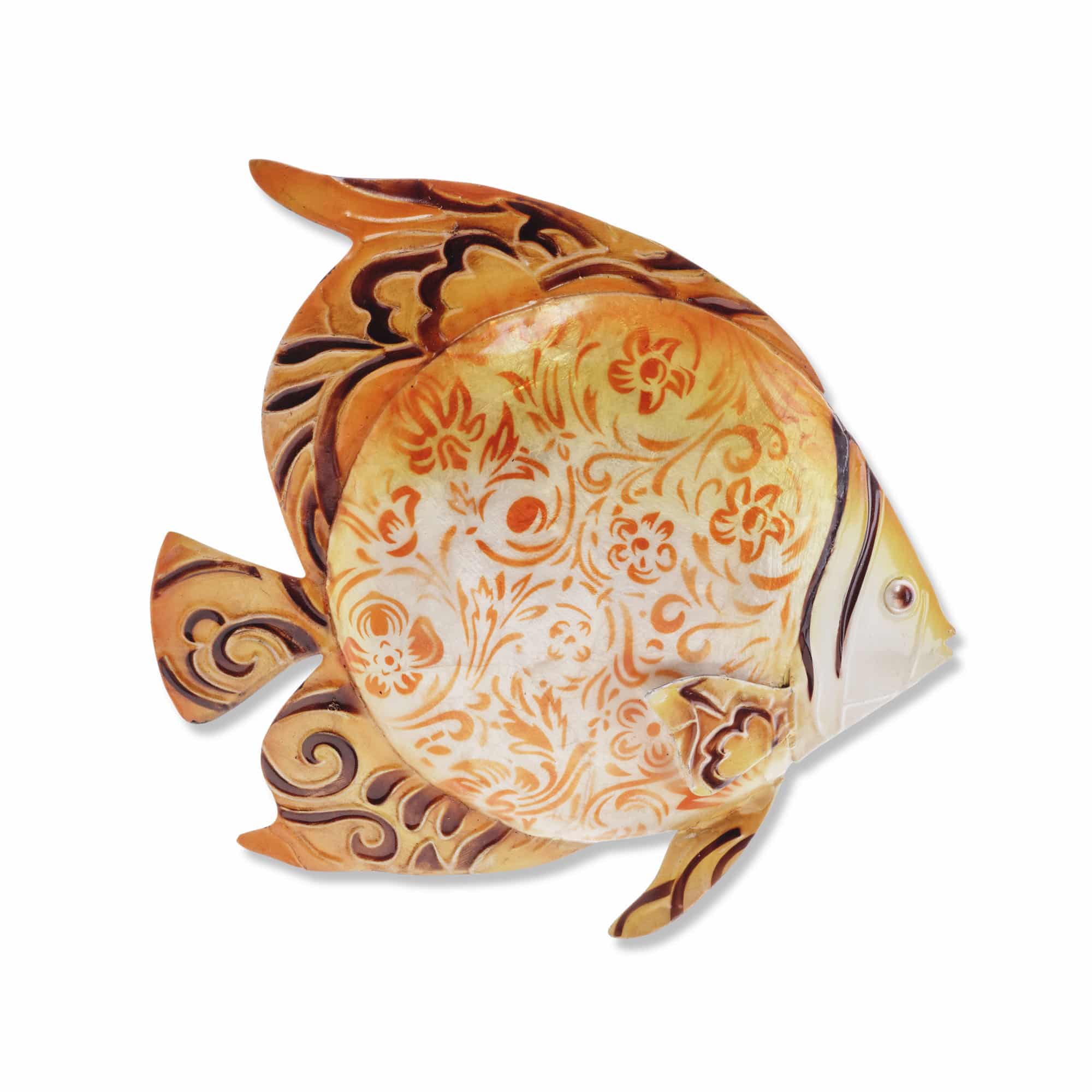 It's big. It's round and it's called an Opah. It looks like a goldfish that seriously outgrew its bowl. The Opah's bright orange is represented in this piece. Instead of spots, the artist took license and painted intricate floral patterns on top of capiz shells. The artist continues by pressing patterns into the tin both in the fins and the face of this magnificent fish. The basic frame of the wall fish is created using tin, which is powder coated as a black finish. The frame is reinforced using wrought iron wire along the inner edge. Capiz is an oyster shell and the primary purpose of the oyster is as a source of food. However, the by-product, the shell, can be used for decoration. Due to it being a natural material, the natural colors of the capiz can come through as tans and browns underneath the paint.
It's big. It's round and it's called an Opah. It looks like a goldfish that seriously outgrew its bowl. The Opah's bright orange is represented in this piece. Instead of spots, the artist took license and painted intricate floral patterns on top of capiz shells. The artist continues by pressing patterns into the tin both in the fins and the face of this magnificent fish. The basic frame of the wall fish is created using tin, which is powder coated as a black finish. The frame is reinforced using wrought iron wire along the inner edge. Capiz is an oyster shell and the primary purpose of the oyster is as a source of food. However, the by-product, the shell, can be used for decoration. Due to it being a natural material, the natural colors of the capiz can come through as tans and browns underneath the paint. -

 This fish was inspired by the Copperband Butterfly Fish. Though the name is a mouthful, the artist did capture the strips, colors, broad fins, and the beak that this fish is known for. The blue and pearl swirls contrast with its deeper bronze fins. Those fins are further enhanced with a swirled design, creating a very complex piece. The results is a piece rich in design and color. The basic frame of the wall fish is created using tin, which is powder coated as a black finish. The frame is reinforced using wrought iron wire along the inner edge. Capiz is an oyster shell and the primary purpose of the oyster is as a source of food. However, the by-product, the shell, can be used for decoration. Due to it being a natural material, the natural colors of the capiz can come through as tans and browns underneath the paint.
This fish was inspired by the Copperband Butterfly Fish. Though the name is a mouthful, the artist did capture the strips, colors, broad fins, and the beak that this fish is known for. The blue and pearl swirls contrast with its deeper bronze fins. Those fins are further enhanced with a swirled design, creating a very complex piece. The results is a piece rich in design and color. The basic frame of the wall fish is created using tin, which is powder coated as a black finish. The frame is reinforced using wrought iron wire along the inner edge. Capiz is an oyster shell and the primary purpose of the oyster is as a source of food. However, the by-product, the shell, can be used for decoration. Due to it being a natural material, the natural colors of the capiz can come through as tans and browns underneath the paint. -

 This fish is an artist's interpretation of the blue sea bass. The rich blue tones are common not only on the fish, but also the water within which it resides. The spiky fines and the scaly skin are also captured by the artist. The center of the fish is most interesting as it is adorned with capiz shell, which is hand-painted in wavy lines, representing the movement of the ocean as well as the fish. This piece will bring in color and design to your space and a smile to your face. The basic frame of the wall fish is created using tin, which is powder coated as a black finish. The frame is reinforced using wrought iron wire along the inner edge. Capiz is an oyster shell and the primary purpose of the oyster is as a source of food. However, the by-product, the shell, can be used for decoration. Due to it being a natural material, the natural colors of the capiz can come through as tans and browns underneath the paint.
This fish is an artist's interpretation of the blue sea bass. The rich blue tones are common not only on the fish, but also the water within which it resides. The spiky fines and the scaly skin are also captured by the artist. The center of the fish is most interesting as it is adorned with capiz shell, which is hand-painted in wavy lines, representing the movement of the ocean as well as the fish. This piece will bring in color and design to your space and a smile to your face. The basic frame of the wall fish is created using tin, which is powder coated as a black finish. The frame is reinforced using wrought iron wire along the inner edge. Capiz is an oyster shell and the primary purpose of the oyster is as a source of food. However, the by-product, the shell, can be used for decoration. Due to it being a natural material, the natural colors of the capiz can come through as tans and browns underneath the paint. -
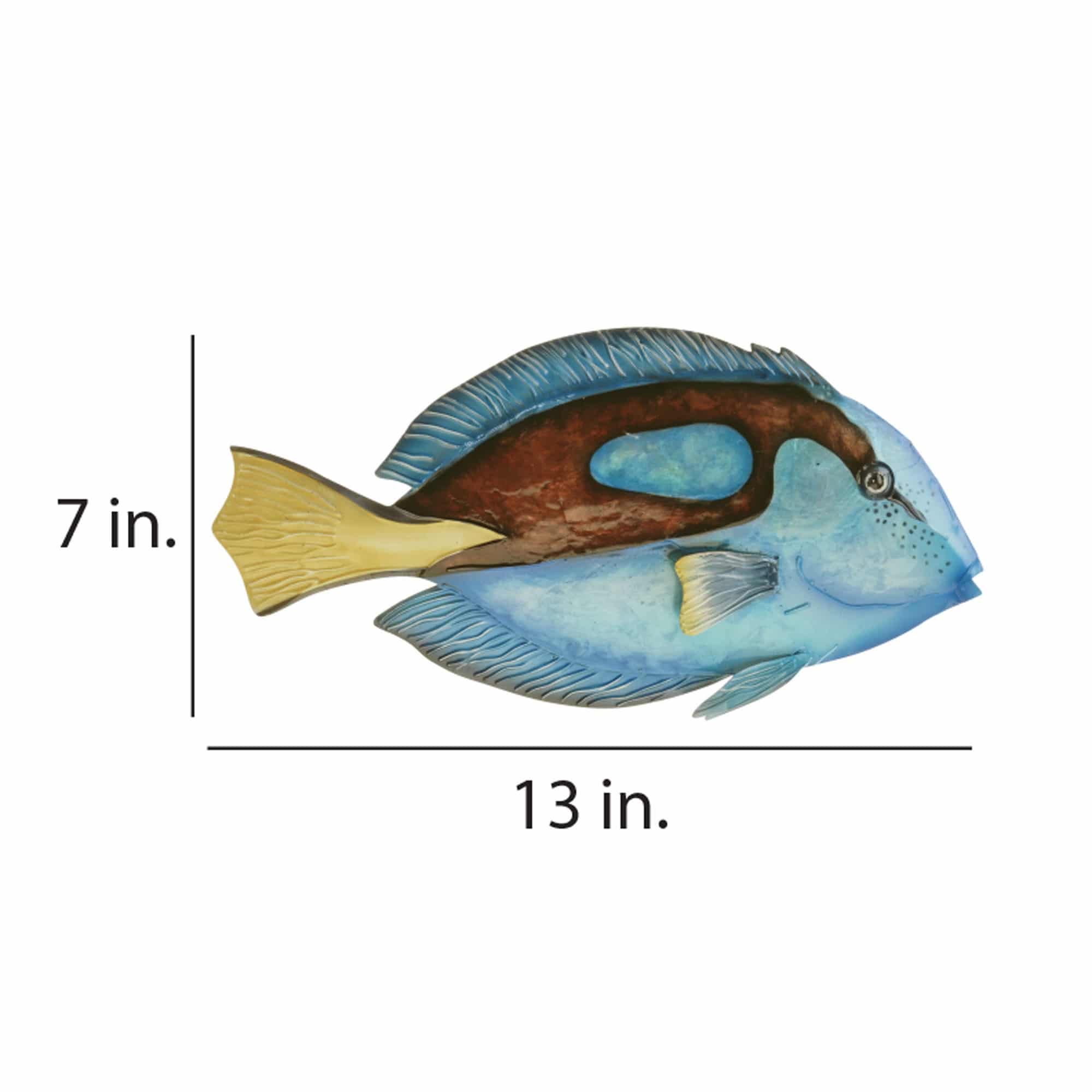
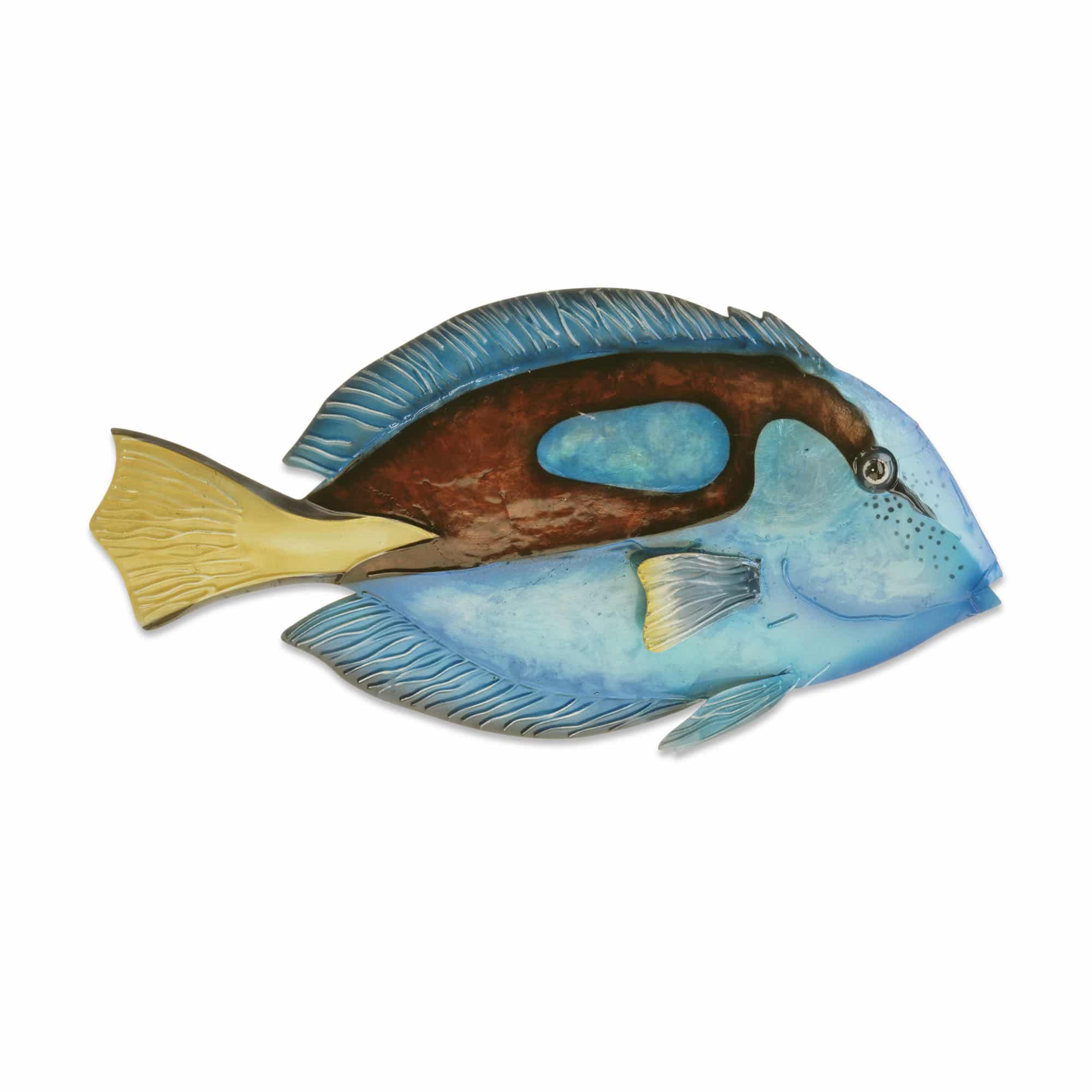 The Blue Tang is a member of a family of fish called durgeonfish. Covering a huge area, this animal can be fround from New York to Brazil. The word tang refers to sharp spines along each side which are said to resemble the scalpel of a surgeon. The artist captures the bright blues and stark blacks that make this species so recognizable and popular. The basic frame of the wall fish is created using tin, which is powder coated as a black finish. The frame is reinforced using wrought iron wire along the inner edge. Capiz is an oyster shell and the primary purpose of the oyster is as a source of food. However, the by-product, the shell, can be used for decoration.
The Blue Tang is a member of a family of fish called durgeonfish. Covering a huge area, this animal can be fround from New York to Brazil. The word tang refers to sharp spines along each side which are said to resemble the scalpel of a surgeon. The artist captures the bright blues and stark blacks that make this species so recognizable and popular. The basic frame of the wall fish is created using tin, which is powder coated as a black finish. The frame is reinforced using wrought iron wire along the inner edge. Capiz is an oyster shell and the primary purpose of the oyster is as a source of food. However, the by-product, the shell, can be used for decoration.



